This Matzo Ball Soup recipe is easy, hearty, cozy comfort food all made in one pot featuring fluffy or dense matzo balls. This classic Jewish Soup is celebrated at Passover but can also be enjoyed any time of year by anyone!
Prepare to fall in love with Matzo Ball Soup! This hearty shortcut recipe is incredibly rich in flavor, ridiculously easy, all made in one pot and make ahead friendly. It features sensational herb studded matzo balls swimming in a savory broth with juicy chicken and tender vegetables. In this recipe, I’m sharing my secrets to choose-your-own-adventure dense or fluffy matzo balls so you can make them perfect for you every time. Make this classic comfort food for Passover, Rosh Hashanah, Hanukkah, Yom Kippur or to warm up to any day of the year. Additionally, this Matzo Ball Soup stores, reheats and freezes beautifully for make-ahead dinner or lunches!
If you’re looking for more hot bowls of soup to cozy up to, look no further than this Matzo Ball Soup, Chicken Noodle Soup, Lemon Chicken Orzo Soup, Creamy Chicken Wild Rice Soup, Chicken Pot Pie Soup, or White Chicken Lasagna Soup.
PIN THIS RECIPE TO SAVE FOR LATER
HOW TO MAKE MATZO BALL SOUP VIDEO
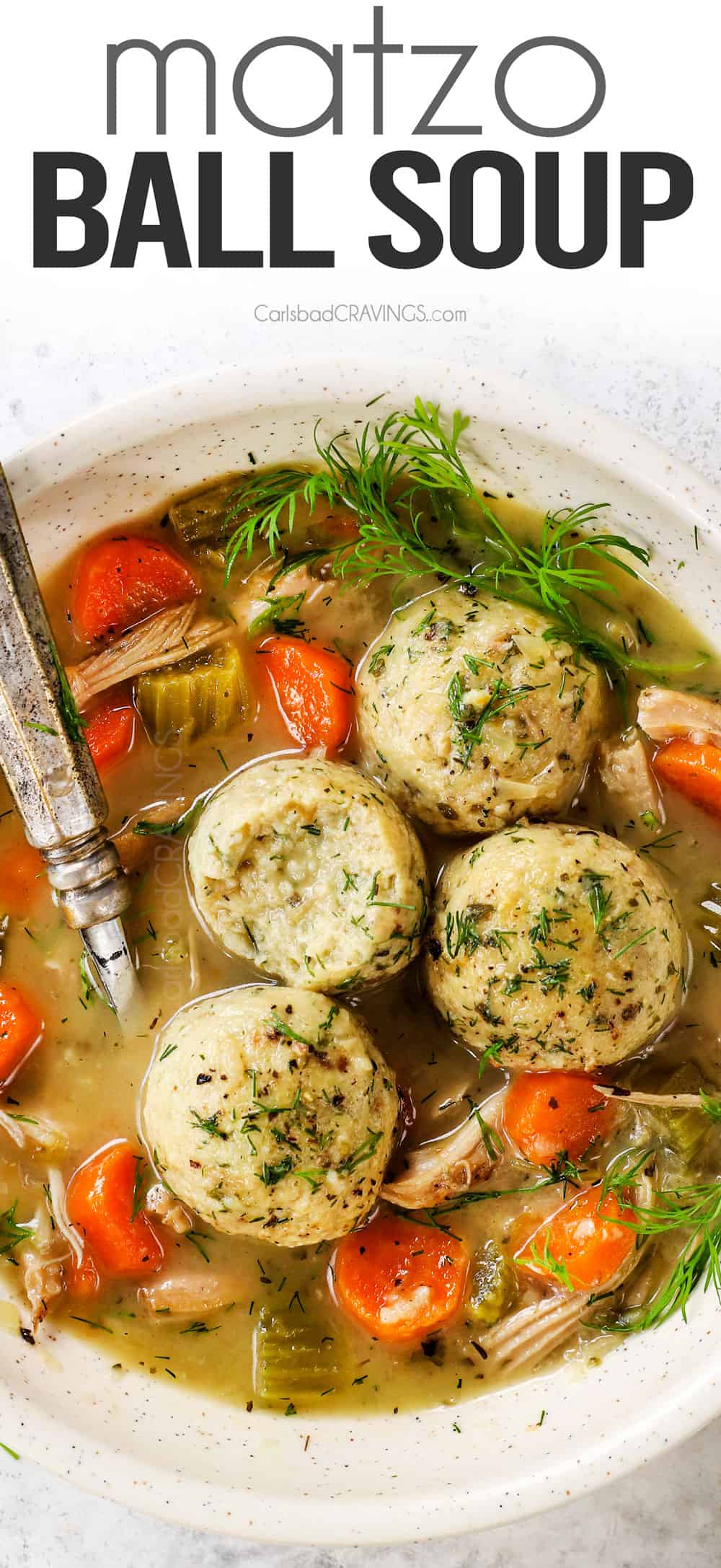
WHAT IS MATZO BALL SOUP?
Matzo or Matzah Ball Soup is a traditional Ashkenazi Jewish chicken soup that is often served at Passover or Rosh Hashanah, but of course, you can enjoy it any time of the year. The matzo balls are dumplings made out of matzah meal (crushed unleavened bread), eggs, schmaltz (rendered chicken fat) and broth. The dumplings are either cooked separately and then added to the soup or I prefer to cook them in the soup to soak up all the glorious flavors.
There are countless variations and family traditions surrounding how Matzo Ball Soup is made from homemade stock to store-bought broth, making homemade matzo balls to using matzah ball mixes, using schmaltz or oil, adding parsnips, carrots, chicken, to whether or not the matzo balls are fluffy or dense (“floaters vs. sinkers”), which means adding seltzer water or baking soda.
Regardless of which variation you enjoy, one thing is certain, making matzah balls couldn’t be any easier. Simply mix the ingredients in a bowl, pop it in the fridge for 30 minutes while the soup simmers, shape the balls, then add them to soup to simmer for about 25 minutes. Uncover the pot and you’re rewarded with soul-warming, herbaceous Matzah Ball Soup.
When is Matzo Ball Soup served?
This Ashkenazi Jewish dish is traditionally served at the start of Passover with family gathered for Seder dinner but is also popular for other holidays such as Rosh Hashanah, Hanukkah and Yom Kippur. Of course, like its mainstream counterpart, chicken noodle soup, Matzo Ball Soup can be enjoyed any time of year, whenever you crave a warm bowl of comfort.
What is the significance of Matzo Ball Soup?
In the Passover meal, Matzah Ball Soup is served to commemorate the Hebrews exodus and freedom from Egyptian slavery. The matzah in matzo balls represents the unleavened bread that the Jews ate while fleeing Egypt into the dessert.
During their hurried exodus (led by Moses), the Israelites didn’t have time to let their breads rise before they fled, so they brought unleavened bread into the desert. As a respectful reminder, Jews cannot eat leavened bread during the Passover, but instead, eat matzah, an unleavened flatbread. This matzah is crushed to form matzo meal which is used to make matzo balls.
my connection to matzo ball soup
My incredible mother-in-law, Marcia, is 98% Ashkenazi Jew (according to DNA tests), with most of her ancestors coming from Russia. Her great grandmother migrated to New York in the 1890s all by herself at the age of 13! She worked hard in a bakery, later married and had six daughters. One of these daughters was Flo, Marcia’s grandmother, a great Jewish cook who taught Marcia how to make Matzo Ball Soup.
The first year Patrick and were married, we celebrated Passover at his parents’ house with a feast of Matzah Ball Soup. I had never tasted anything like it. The broth was incredibly rich, deep and savory, the matzo balls tender, light, ethereal dumplings I craved in every slurpful. So, while I am not Jewish myself, I respect Jewish traditions, honor the Hebrew exodus, and am excited to share a version of Matzo Ball Soup with you today.
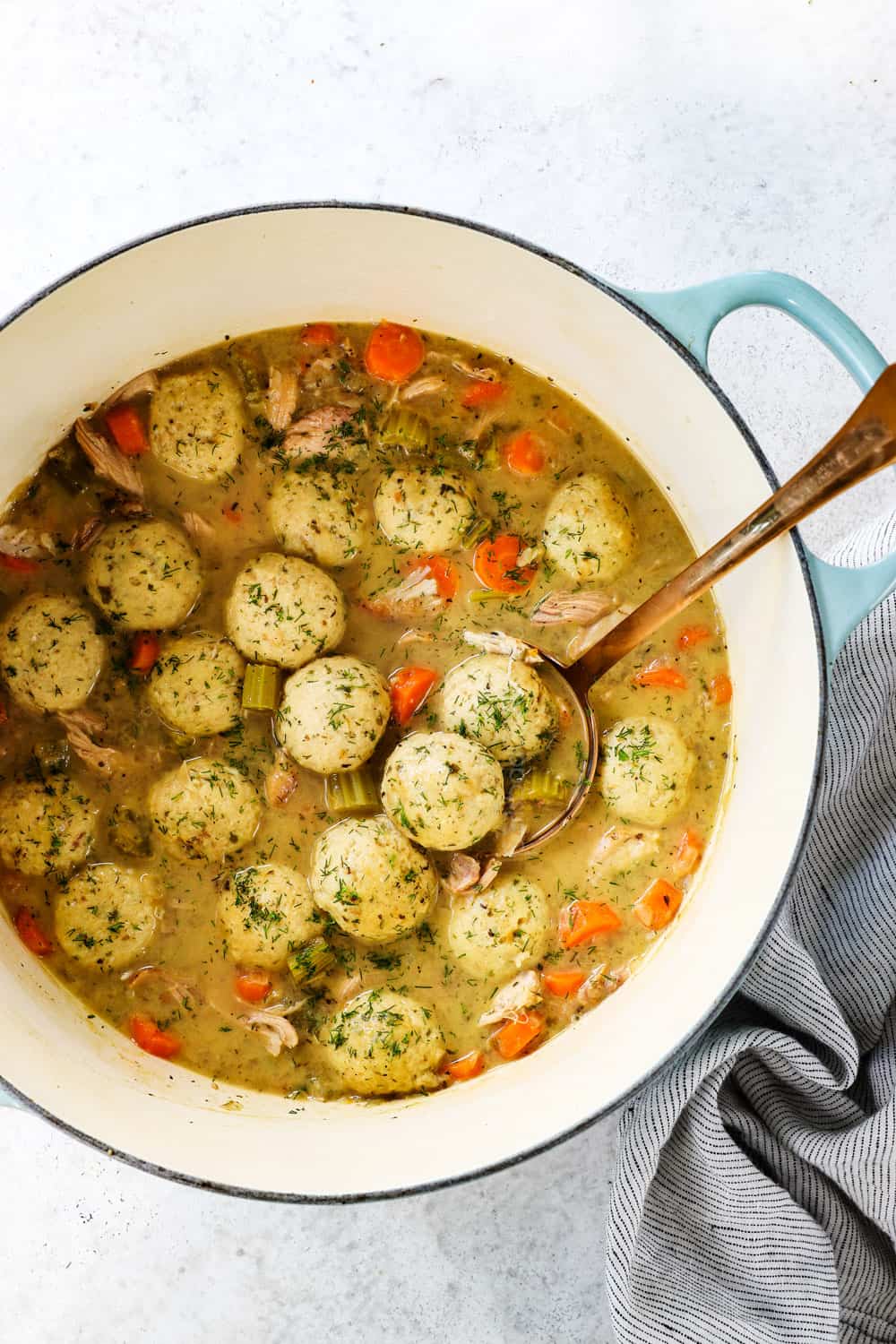
why this matzo ball soup recipe works
Every spoonful of this Matzo Ball Soup recipe is a warm, aromatic, symphony chock full of fluffy, rich matzah balls, juicy chicken, carrots, celery, and dill. Here’s why this recipe works:
- Shortcut broth means quicker Matzo Ball Soup! You are welcome to use homemade stock, but this shortcut broth is whipped up in just 20 minutes and is just as flavorful.
- The shortcut broth delivers all the flavor of cooking a whole chicken – without any of the work! It’s made by simmering bone-in chicken thighs, chopped onions, carrots, celery and chicken bouillon which enrich the broth with concentrated flavor and body.
- Choose between sinkers or floaters. Some people are camp sinkers, some people are camp floaters, so this recipe lets you choose the matzo balls of your dreams simply by adding baking powder or omitting baking powder (kosher version included) or seltzer water.
- Using schmaltz (rendered chicken fat) in the matzah balls imparts a deep, rich chicken flavor. This one ingredient creates the most crave worthy dumplings. You also have the choice to use vegetable oil for convenience.
- Seasoning the matzo balls rounds out the complex flavors. No one note, bland dumplings here! They are seasoned with fresh, dill, fresh parsley, onion powder, garlic powder and pepper.
- Letting the matzah ball mixture rest creates easy to shape dumplings. They also cook up lighter and fluffier if you choose.
- Poaching the matzo balls in chicken broth instead of water produces the most flavor-packed dumplings you ever tasted. Matzah balls are like sponges and cooking them in broth makes them 10X more flavorful. It requires more broth – but is SO worth it.
- Using simple, inexpensive ingredients means you can make this recipe any time. The matzo meal is pantry friendly and this recipe can be made with any chicken you have on hand.
- The matzo meal mixture and the balls can be made a day ahead of time. This allows you to prep some of the soup in advance and makes for even fluffier dumplings.
What are Matzo Balls?
Matzo balls are a popular type of knaidel (plural knaidelach), an Ashkenazi Jewish dumpling added to soups or stews. In order to be considered kosher for Passover, matzah balls cannot contain any leavened grain, meaning any breads leavened with yeast. Instead, matzo meal, crushed unleavened bread, is used combined with eggs, schmaltz (rendered chicken fat), broth and herbs.
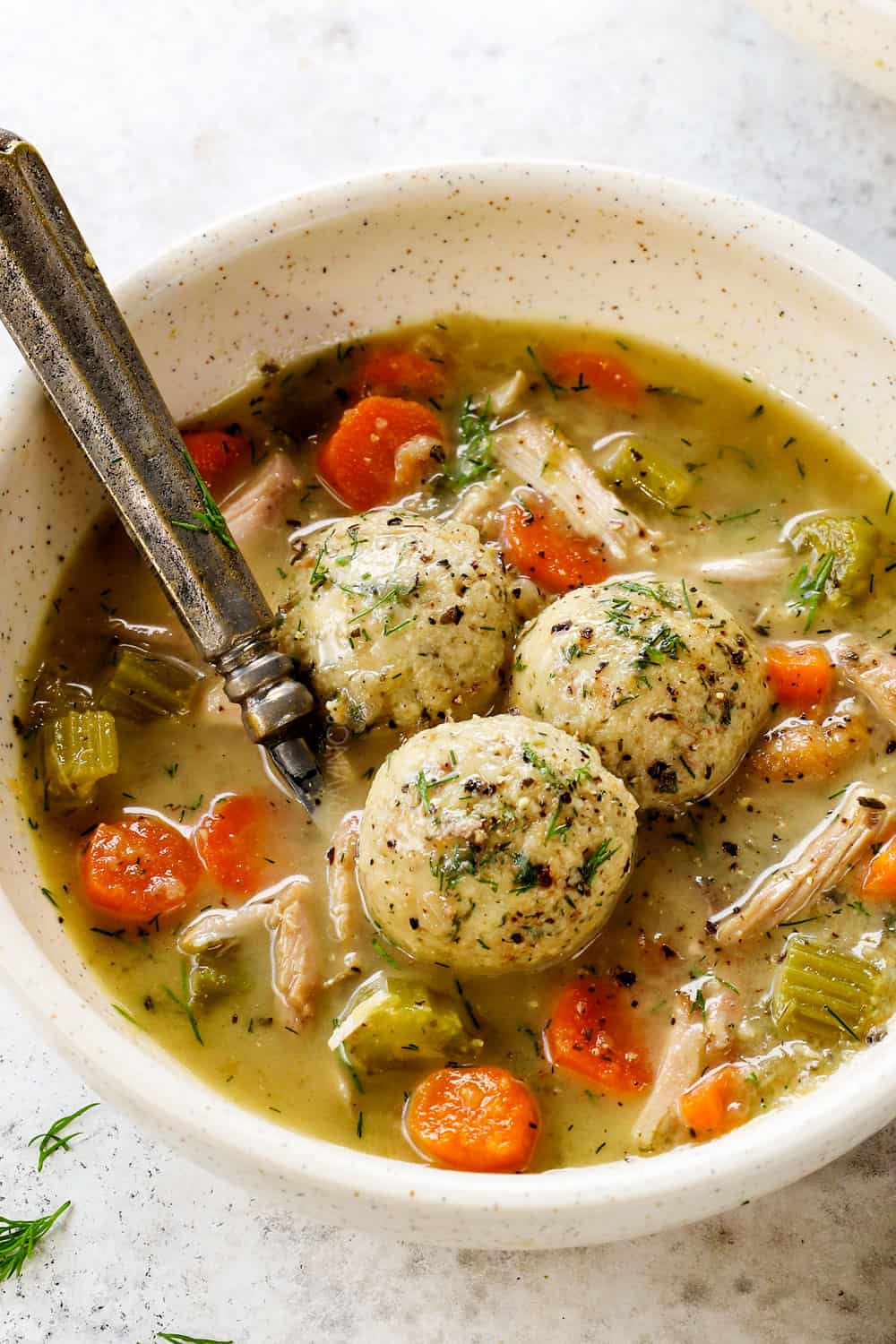
Ingredients for Matzo Balls
To make matzah balls, you will need the following (exact measurements in the recipe card at the bottom of the post):
- Matzo meal: This is finely ground matzo, traditional Jewish unleavened bread or crackers that’s also known as matzah or matzoh. It is kosher for Passover made of only wheat flour and bread. You can find matzo meal in the same aisle as the breadcrumbs. I use commonly found Manischewitz Matzo Meal. Do NOT confuse matzo meal with matzo ball mix!
- Eggs: The eggs are necessary to bind all the ingredients together and give the dumplings structure.
- Baking powder: An optional leaving agent that make the matzah balls soft and fluffy. See details about whether it’s kosher below.
- Chicken broth or seltzer water: I choose to use chicken broth plus baking powder for light matzo balls with substance but you can also use carbonated water in place of the broth which aerates the dough.
- Herbs and seasonings: Like meatballs, even matzah balls need to be independently seasoned. We use minced fresh dill, parsley, onion powder, garlic powder, salt and pepper.
- Schmaltz: Also known as liquid gold, schmaltz is fantastically rich rendered poultry fat (usually chicken) and HIGHLY recommend if you’re serious about making the most tantalizing dumplings with concentrated flavor. It also promotes more tender dumplings.
- Where can I buy schmaltz? Look for schmaltz in the kosher section of your grocery store, stocked near the oils, in the freezer section, or ask the butcher, they often sell it directly. You can also purchase it on Amazon here or you can make your own schmaltz.
- What if I don’t have schmaltz? If you can’t get your hands on schmaltz, you can swap it for a neutral oil such as vegetable oil or canola oil, but as the descriptor implies, these are lacking in flavor. You can also use melted butter but this is not kosher during Passover.
Fun Fact: Why schmaltz?
Schmaltz is a common ingredient in Jewish and Eastern European cooking because it is inexpensive, diary free and doesn’t compromise Jewish kosher dietary laws (those keeping to a kosher diet can’t eat meat and dairy together in a single meal). Schmaltz is also rich in flavor like butter and a favorite among many chefs. It can be used in place of butter in practically any application such as caramelizing onions, sautéing vegetables, tossed with roasted vegetables, in cornbread or biscuits.
Floaters vs. Sinkers
There is a great matzah ball debate – some people prefer airy, softy and fluffy matzo balls that bob on the surface while they cook, “floaters;” some prefer dense, richer ones with a toothsome quality that sink to the bottom of the pot, “sinkers.”
Light matzo balls have more air pockets which means they are more sponge-like and able to absorb more broth, and therefore taste more like broth. They are often made lighter with the use of baking powder, seltzer water or whipped egg whites, or a combination. In fact, my mother-in-law said she always had the most successes making light dumplings with Manischewitz Matzo Ball Mix and could never replicate them using matzo meal. It turns out, Manischewitz Matzo Ball Mix has sodium bicarbonate and monocalcium phosphate– both active ingredients in baking powder!
Dense matzah balls, on the other hand, are chewier, heartier, less brothy and taste more like the wheat matzo and rich schmaltz they are made of.
My personal preference, as specified in the recipe, is somewhere in the middle by using baking powder but skipping the seltzer water which makes them almost too fluffy and not as flavorful because the seltzer water takes the place of broth. These middle ground dumplings are still light, soft and tender, able to absorb broth but still hearty enough to not border on mushiness.
How to make floaters or sinkers:
- For the lightest matzo balls: use seltzer water in place of the broth and add anywhere from ¼ teaspoon to ¾ teaspoon baking powder (more baking powder will yield increasingly light matzo balls; ¾ teaspoon with be insanely light)
- For light matzo balls with some substance (my personal preference): use ¾ teaspoon baking powder and stick with chicken broth instead of seltzer water
- For matzo balls slightly lighter on the outside but still a bit dense in the middle: use seltzer in place of the broth and skip the baking powder OR skip the seltzer and use only 1/4-½ teaspoon baking powder
- For dense matzo balls: skip the baking powder and stick with broth instead of seltzer water
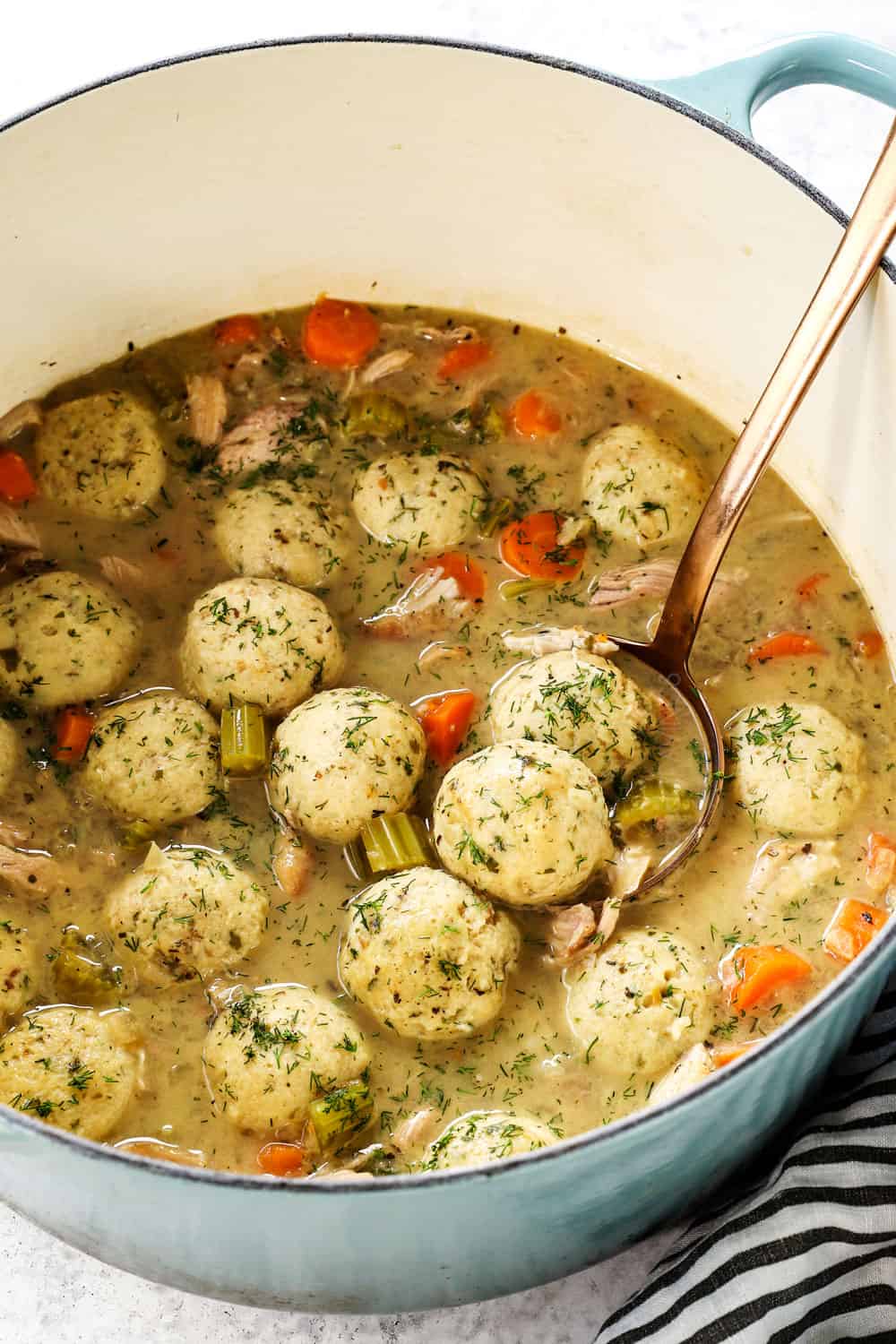
Is baking powder kosher for Passover?
Yes! If you’re concerned about whether using baking powder is kosher for Passover because it is a leavening agent, fear no more. Baking powder is an artificial, mineral based, non-grain-based form of leavening, and therefore it does not fall under the group of foods that are banned for Passover.
Apparently, “leavening” refers to yeast, not baking soda or baking powder. In this New York Times article, Rabbi Moshe Elefant, executive rabbinic coordinator and chief operating officer of the Orthodox Union’s kosher division, says: “There is nothing wrong about a raised product at Passover per se.”
Still, some choose not to use baking powder to keep with the spirit of the Passover. If you are concerned, there are several baking powder brands stated “certified for Passover” or they may say Parve or Pesadich. This one by Gefen sold on Amazon is a popular choice.
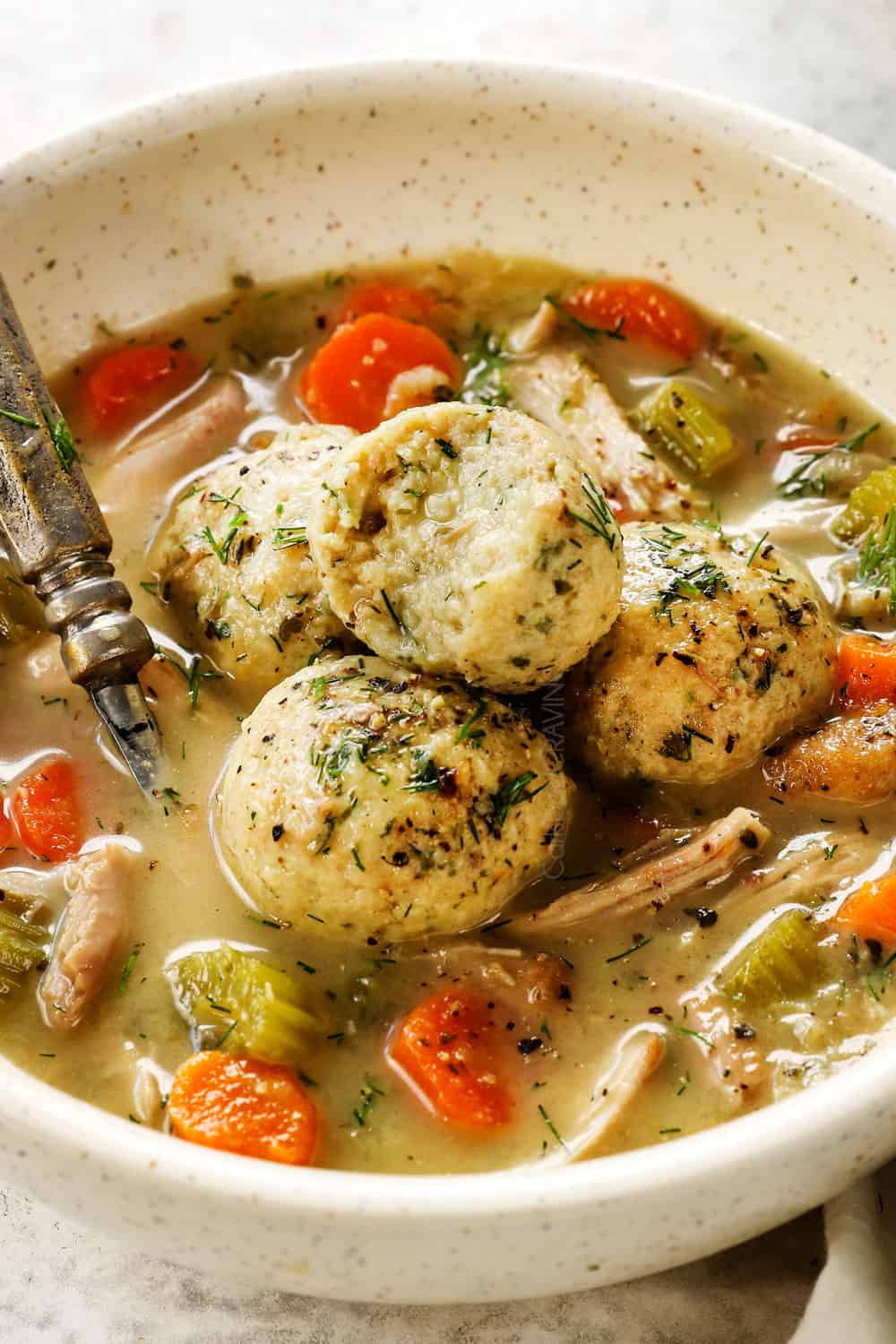
Matzo ball Ingredient Questions and Answers
- Can you make matzo balls from matzo crackers? Yes, matzo meal is simply ground matzo crackers. To make matzo balls from matzo crackers, process them into fine crumbs in your food processor or crush them with a rolling pin or side of a can. You will need ¾ cup crumbs cup for this recipe.
- Can you make matzo balls with saltine crackers? You can make matzo balls with saltine crackers but they will not be kosher because saltines contain yeast. To make, process the soda crackers in a food processor to form fine crumbs and use in place of matzo meal. You will need to significantly reduce the salt in the recipe because saltines are already salty.
- Can I use flour instead of matzo meal? If you run out of matzo meal, flour of any kind is not recommended as a replacement for matzo meal. Remember, matzo is ground crackers, whereas flour is finer and hasn’t been baked. When it is not Passover, you can try using other crackers like saltine crackers or Ritz or even plain bread crumbs and reducing the salt as needed.
- Is matzo meal the same as matzo ball mix? No, matzo meal and matzo ball mix are not the same. Matzo meal is simply ground up matzo crackers made of flour and water. Matzo ball mix is a pre-packaged mixture of matzo meal, spices (salt, pepper, garlic powder, onion powder, celery seed, etc.), and preservatives. It also contains sodium bicarbonate and monocalcium phosphate– both active ingredients in baking powder to make the balls lighter.
- Can I use matzo ball mix instead of matzo meal? Yes, you can use matzo ball mix instead of matzo meal and follow the recipe on the box to create light, fluffy matzo balls. If you are looking for dense matzo balls, then the mix is not for you. The mix typically calls for adding eggs and oil to the pre-seasoned matzo meal, but feel free to add additional herbs such as fresh dill and parsley. You can also swap the oil for schmaltz instead.
- Can I use duck fat for matzo balls? Yes, you can use duck fat in place of schmaltz for the matzah balls.
ingredients for matzo ball SOUP
What I love most about this Matzo Ball Soup recipe is that it’s packed with flavor, but is made with pantry friendly, easy to find ingredients. So, now that we have the matzah balls squared away, let’s take a closer look at what you need for the soup portion (full recipe measurements in the recipe card at the bottom of the post):
- Chicken thighs: I highly recommend bone-in chicken thighs with the skin removed. The succulent, rich dark meat and bone makes for extra rich broth and tender chicken. In fact, my husband, was effusive that this was the “richest, most complex” broth he had ever tasted. It creates broth richer than breasts or even boneless thighs. Additionally, chicken thighs are dark meat which means they are inherently juicier, more tender and difficult to overcook.
Can I use chicken breasts? You can absolutely still use chicken breasts for this recipe if that is what you prefer but I don’t find breasts as juicy or flavorful. Take care to use chicken stock instead of broth if using breasts otherwise the soup won’t be as rich and flavorful. If using chicken breasts, I suggest bone-in chicken breasts but boneless will also work. You will want to slice your breasts in half through the equator if they are extra-large, otherwise, the simmer time will be much longer and the veggies can break down too much.
- Chicken broth: While purists will encourage only homemade chicken stock, this isn’t always practical and can discourage many from making Matzo Ball Soup. For this recipe, you are welcome to use your own homemade stock (omit the bouillon in the recipe) or store-bought low sodium chicken broth. The broth is simmered with bone-in chicken thighs, chopped carrots, celery and onion as well as chicken bouillon which amps up the flavor and makes it taste like it’s been simmering for hours.
- Chicken bouillon: The bouillon adds an even richer, deeply satisfying concentrated chicken flavor. You can use granulated bouillon (powder), bouillon cubes or better than bouillon in equal amounts. Add the bouillon to the soup without dissolving in liquid first.
- Chicken schmaltz: This is used in place of oil or butter to sauté the vegetables, although you can use olive oil if you’d like.
- Onion: Use one diced yellow onion. When a recipe doesn’t specify a type of onion, use yellow onion. You may substitute with 1 ½ teaspoons onion powder if you’re in a bind.
- Garlic. 4-6 garlic cloves, depending on your garlic love or substitute with 1 teaspoon garlic powder if you’re in a bind – but fresh is always best!
- Celery: You’ll need 1 cup chopped celery. Chop the celery on the larger side, ½ -inch chop, so it doesn’t become mushy in the soup.
- Carrots: You’ll also need 1 cup, sliced ¼-inch thick so they cook in the same amount of time as the celery.
- Seasonings: Dried parsley, oregano, basil, thyme, and bay leaves infuse the broth with herbaceous goodness. Fresh dill finishes the soup with fresh citrus earthiness and salt and pepper awaken all of the flavors. As with all recipes, adjust the seasonings to taste to make it perfect for you.
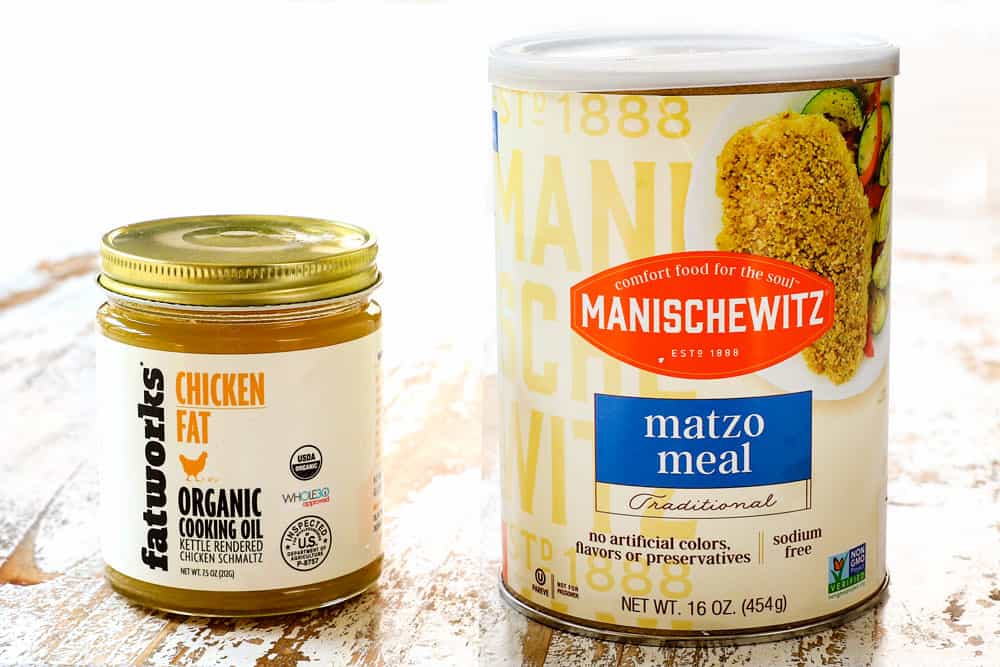
HOW TO MAKE MATZO BALL SOUP
This soothing Matzo Ball Soup fills the belly and warms the soul and is easier to make than you think! Essentially, we are making chicken soup then adding the matzah balls and simmering another 25 minutes. Here’s how to make it (full recipe with measurements in the recipe card at the bottom of the post):
Step 1: Mix the matzo ball dough
First, you’ll mix together all of the dry ingredients: the matzo meal, baking powder (if using), dill, parsley, salt, garlic powder, onion powder, and pepper. In another small mixing bowl, whisk together the eggs, schmaltz (or oil) and chicken broth. Pour the egg mixture into the dry ingredients and fold together just until combined; do not over-mix.
Cover and refrigerate the mixture for 30 minutes or until ready to use. You can form the balls any time after 30 minutes and refrigerate for up to two days.
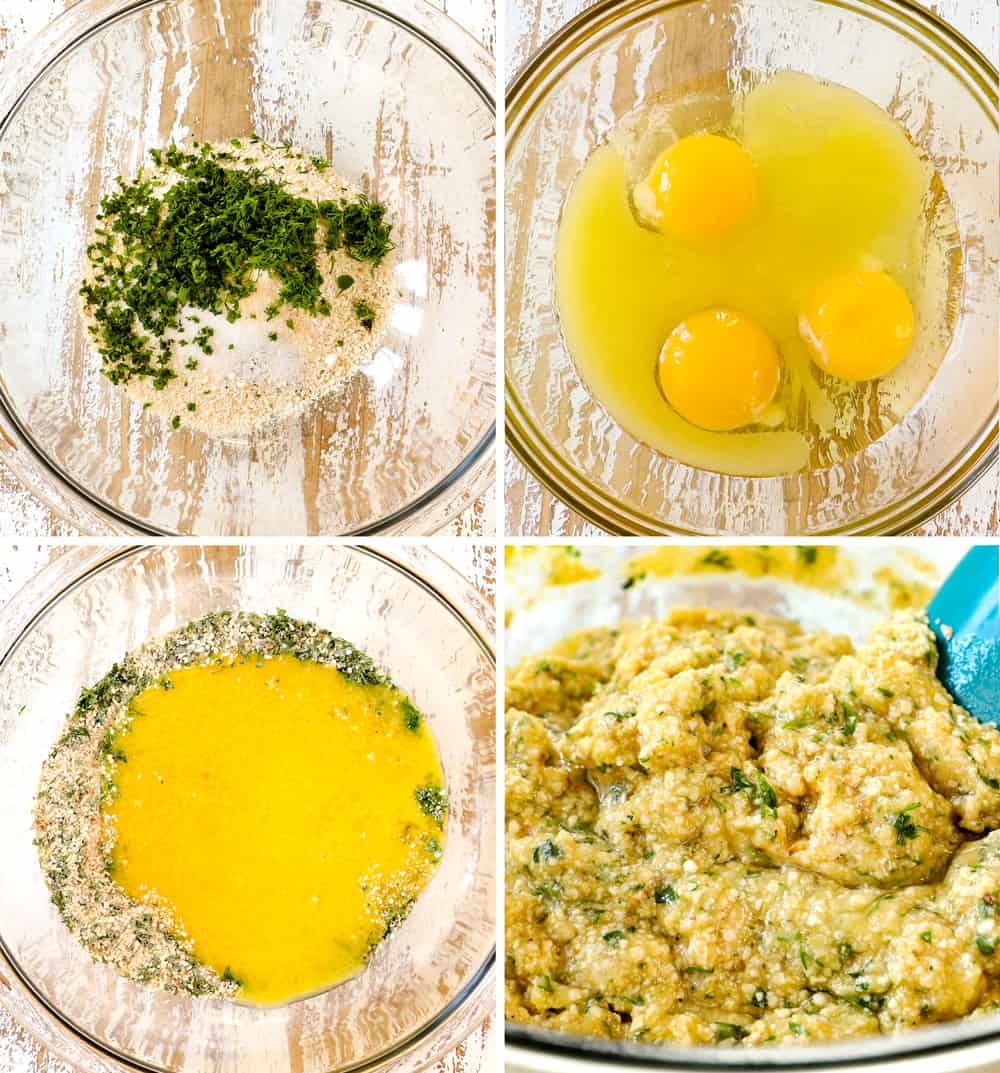
Step 2: Sear the chicken
Start by patting the chicken dry with paper towels then evenly sprinkle with salt and pepper. Drying the chicken allows the seasonings to stick and letting the chicken rest while you prep the veggies helps the seasonings penetrate the chicken.
Sear chicken in rippling hot oil for about 3 minutes per side. Remove to a plate but leave the glorious drippings. Searing the chicken results in the Maillard reaction, in which amino acids and reducing sugars produce browning, and as we know, color= flavor! The delicious brown bits left in the bottom of the pan will season the entire soup as they permeate the broth.
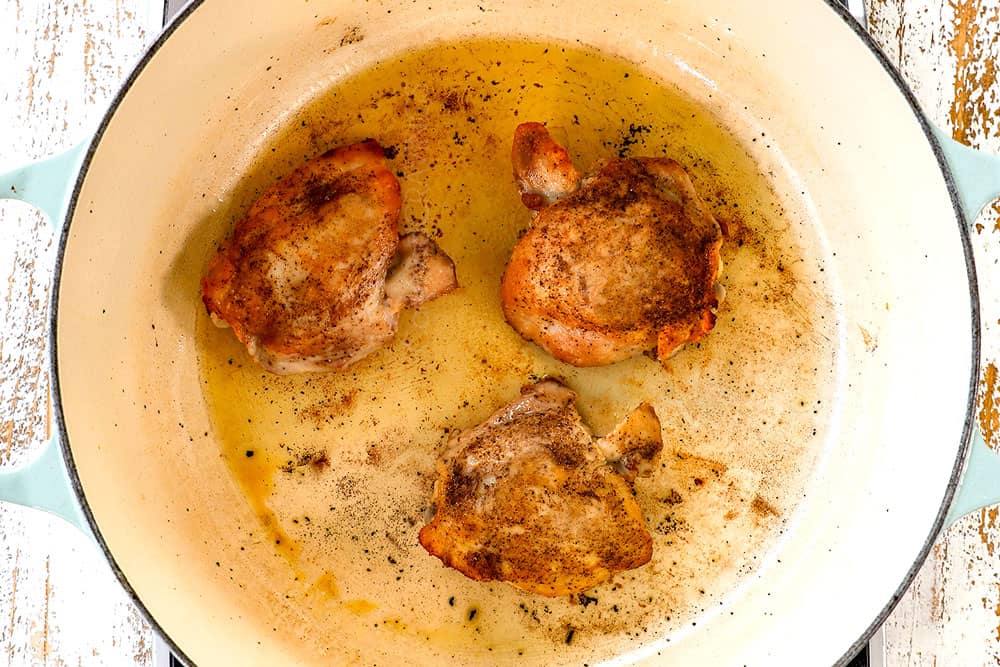
Step 3: Sauté the vegetables
This recipe boasts the classic combination of carrots, onions and celery known as the holy trinity of cooking and provide a richness and depth of flavor. You can sauté them in additional olive oil or schmaltz instead. You’ll sauté them until the onions are tender and then add the garlic, making sure to scrape up the brown bits on the bottom of the pan.
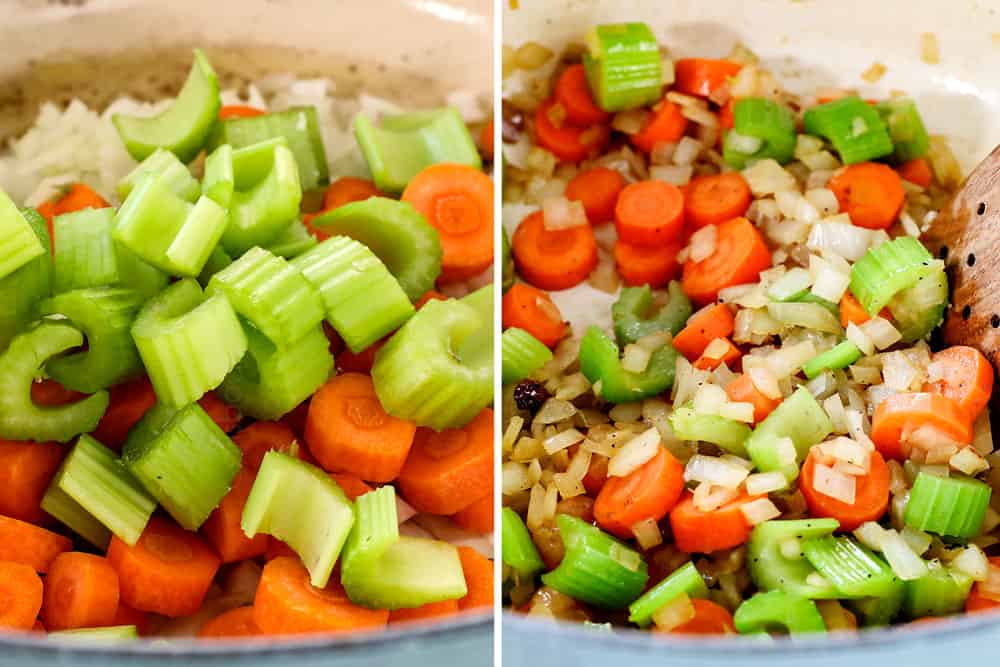
Step 4: Add the broth and seasonings
Add the seared chicken back to the pot along with chicken bouillon, all seasonings, bay leaves and chicken broth.
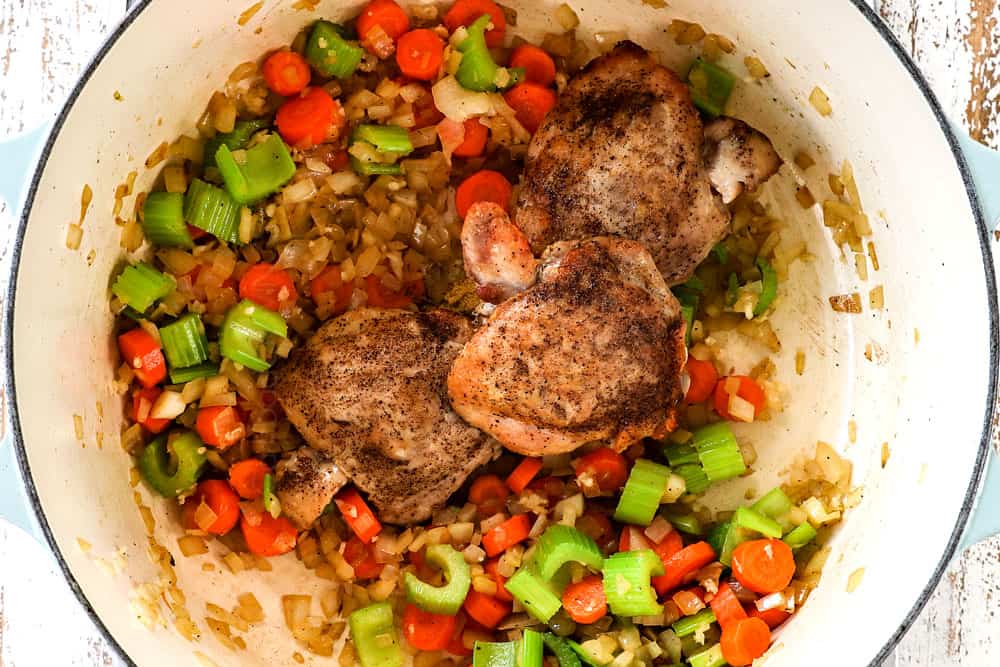
Step 6: Simmer the soup
Cover the soup and simmer for about 20 minutes or until the chicken is tender enough to shred.
Step 7: Make the Matzo balls
While the chicken is simmering, line a 9×13 dish or baking sheet with plastic wrap or parchment paper to receive matzah balls. This makes it easy to transport the balls and pop them back into the fridge if you finish before the soup is ready.
To form the balls, wet your hands with cold water, then roll scoops of batter (about 1 tablespoon each) into balls, handling them as gently as possible. Place the balls on the parchment/plastic and refrigerate until ready to use.
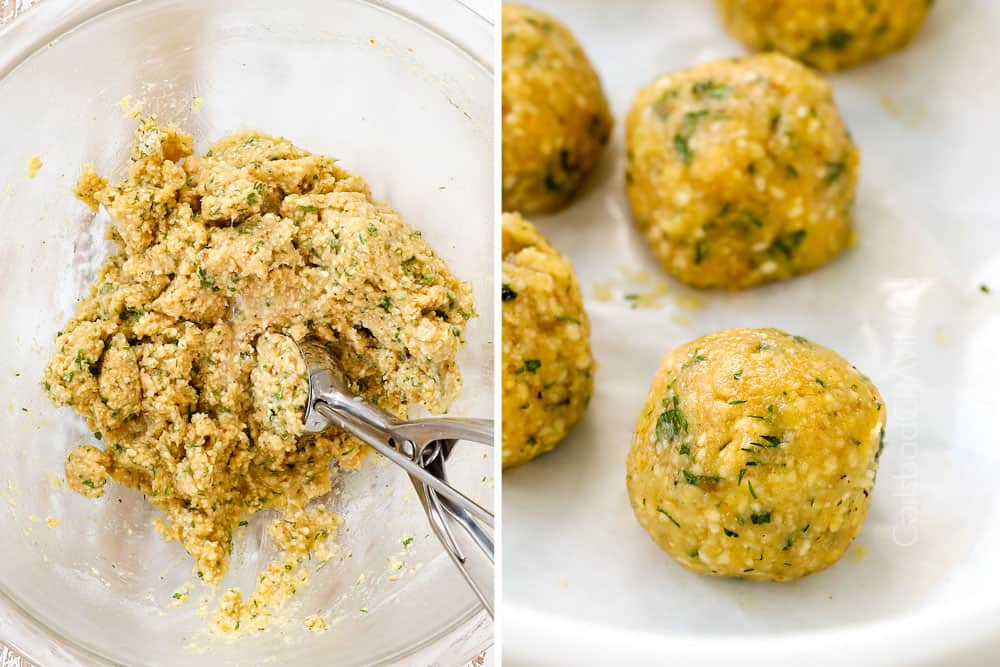
Step 8: Add the chicken and matzo balls
Transfer chicken to a cutting board and shred into bite-size pieces once cool enough to handle. Add chicken back to the soup so the broth can permeate every nook and cranny of the chicken.
Bring the soup to a simmer, then drop the balls into the soup, cover and simmer for 25-30 minutes, until they are plump and cooked through. Stir the dill into the soup and dig in!
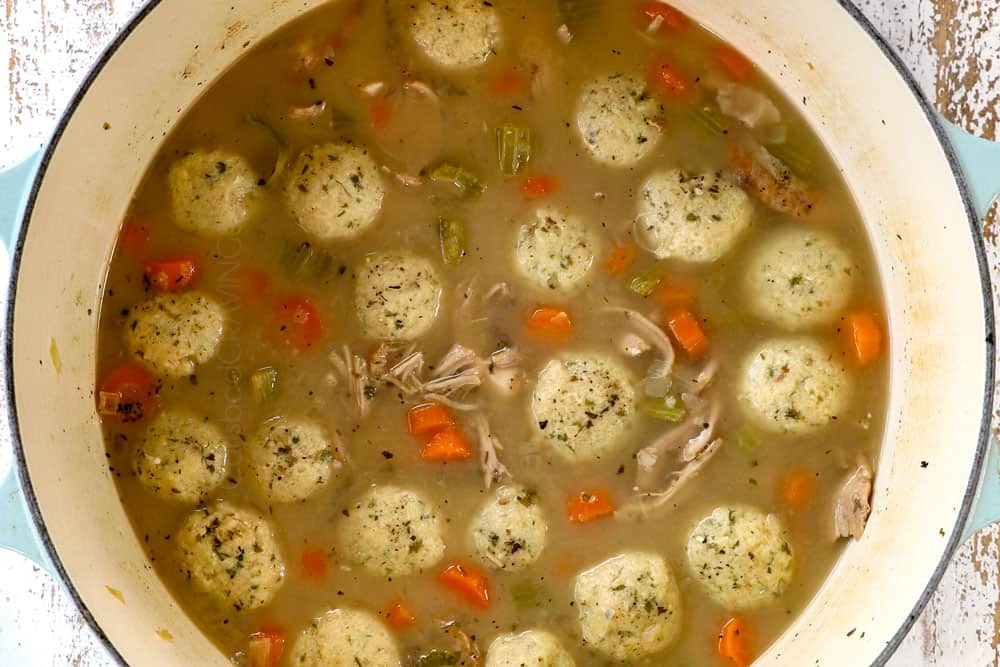
How do you know when matzo balls are done?
“Floaters” will begin to bob to the surface of the broth as they cook, but this doesn’t mean they are done. When done, the matzah balls should all be floating on the top of the soup and will have doubled in size. To check for doneness, remove a ball after 25 minutes and test with a toothpick or slice in half; they are done when the dumpling is the same color and consistency throughout and are no longer doughy.
TIPS AND TRICKS FOR BEST MATZO BALL SOUP
Follow these guidelines for the most successful Matzo Ball Soup recipe every time:
- Use matzo meal: We want to control the seasonings and baking powder in the recipe, so take care to use matzo meal instead of matzo ball mix.
- Chill the matzo mixture: The mixture should be chilled for at least 30 minutes up to 2 days before shaping the matzo balls. This gives the matzo meal time to absorb the liquid, resulting in more cohesive matzo balls that don’t fall apart during cooking.
- Use a cookie scoop: The quickest, easiest way to make uniform matzah balls is to portion them with a cookie scoop before briefly rolling.
- Roll matzo balls with wet hands. Just like meatballs, it helps to wet your hands with cold water to prevent the dough from sticking. You can also spray them with nonstick cooking spray.
- Chop vegetables the correct size: Chop carrots and celery as prescribed in the recipe. Avoid chopping your vegetables too thin or they can become mushy.
- Use stock or broth: If using chicken breasts, I recommend using chicken stock because it’s richer in flavor because it’s made up of chicken bones which are cooked with vegetables for four times as long as broth. If using bone-in chicken thighs, I still found it incredibly rich with chicken broth, and almost too rich with stock.
- Chop vegetables the correct size: Chop carrots and celery as prescribed in the recipe. Avoid chopping your vegetables too thin or they can become mushy.
- Should I cook the matzo balls in water or the chicken stock? Matzo balls are little sponges and will soak up anything they are cooked in. If cooked in water, they will be bland, if cooked in broth, they will be full of flavor. For ease, I cook the dumplings directly in the soup; it saves you from dirtying another pot and makes for the most flavorful matzah balls. Cooking the dumplings directly in the soup will make it a little cloudy due to the starch (I don’t mind a bit), so if this bothers you, then cook the balls in a separate pot of 2 quarts of simmering broth and reduce the broth in the soup.
- Keep the pot covered while cooking the matzo balls: It’s okay to have a peak and stir every now and then, but you should try and limit the times the dumplings are uncovered or they won’t bake as quickly, evenly or expand nearly as much.
- Add additional broth as needed: The matzah balls will absorb a significant amount of broth as they simmer and expand. The amount of broth will vary depending on whether you used carbonated water, baking powder, the simmering time, etc., so be prepared to additional broth if you’d like the soup less chunky.
- Don’t burn the bits: When searing the chicken, you don’t want blackened bits, or they will make your soup taste burnt. If the chicken is browning too quickly, turn the heat down.
- Simmer chicken until tender: Whether using chicken thighs or breasts, check the pieces individually for tenderness when simmering because they may cook unevenly. Be prepared to remove pieces of chicken at different times. The chicken is ready when it easily pulls apart with two forks, not any sooner.
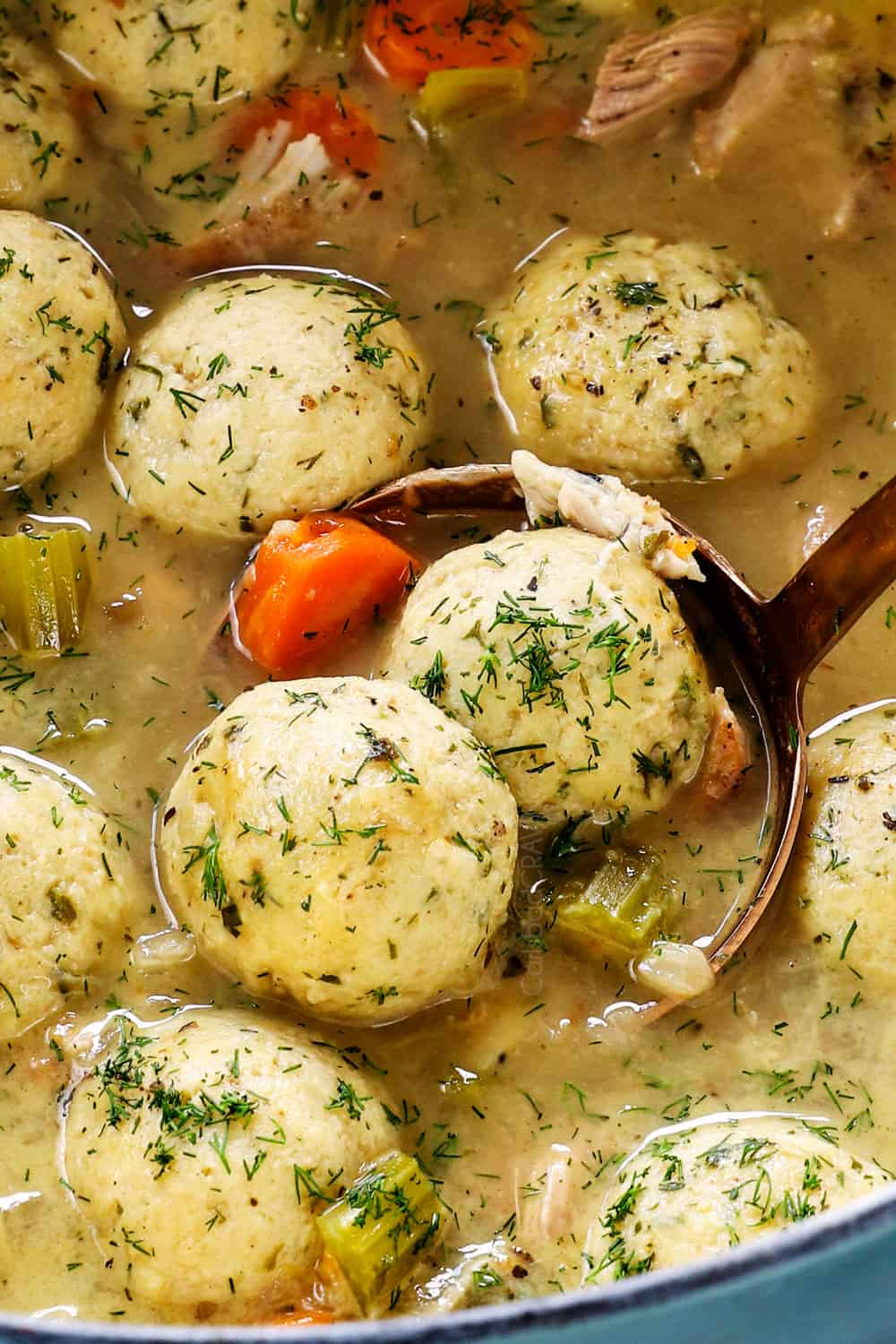
RECIPE VARIATIONS
There are countless variations of homemade Matzo Ball Soup, so don’t be afraid to venture out of your comfort zone and even make your own tradition! Here are some possible recipe variations:
- Omit the chicken: Serve just the matzo balls with homemade stock and vegetables as desired.
- Rotisserie chicken: Use chicken stock along with shredded rotisserie chicken. Rotisserie chicken comes lightly seasoned for an added depth of flavor and is a mix of both light and dark meat. It also comes perfectly tender and ready to slurp up. I always like to stock shredded rotisserie chicken portioned into 2-3 cup measurements in my freezer so they’re ready to add to any soup or casserole recipe. I recommend shredding your rotisserie chicken as soon as you get home from the grocery store because the chicken is easier to shred while it’s still warm.
- Shortcut Easy Matzo Ball Soup: To make this recipe in a hurry, purchase pre-chopped vegetables and rotisserie chicken and use chicken stock instead of broth. Sauté the vegetables, add the shredded chicken, bring the stock to a simmer, then add the matzo balls to cook.
- Swap veggies: Parsnips are a popular addition and my mother-in-law always adds peas. You can also go all sorts of non-traditional with green beans, mushrooms, zucchini, corn, potatoes, broccoli, spinach, kale, etc.
- Noodles: Some love the addition of egg noodles to their Matzo Ball Soup. Cook them separately then add to the soup at the end or to individual bowls. You will likely need additional broth to accommodate the noodles.
- Herbs: Swap the herbs for fresh chives and thyme added the last 5 minutes of cooking. You can also add additional herbs such as sage, tarragon, etc. or spice it up with red pepper flakes.
- Use homemade chicken stock: To make your own stock, place a whole chicken or 6 skin-on chicken drumsticks, and 6 skin-on chicken wings in 12 cups of water along with 3 carrots cut into chunks, 3 celery stalks, cut into chunks, 2 parsnips cut into chunks, 2 onions, peeled and quartered, 1 head garlic, cut horizontally in half, 1 bay leaf, 1 tablespoon black peppercorns and 1 tablespoon kosher salt. Bring to a simmer and cook for 3 hours. Strain the broth, reserve some carrots and celery to add to individual bowls of soup and remove the chicken meat from the carcass. If not using right away, allow to cool, then reserve a few tablespoons of the skimmed fat for homemade schmaltz in the matzo balls. Simmer the matzo balls in the homemade chicken stock.
- Homemade schmaltz: You can ask the butcher for saved skin and fat (use 2 cups for this recipe), otherwise, use the finely chopped skin of about 8 chicken thighs or 2 cups; the skin is easier to chop if it’s partially frozen. Add the skin and fat to a heavy bottom saucepan along with ¼ cup water and bring to a simmer. Reduce the heat to low and cook, stirring occasionally, until the scraps render most of their fat and begin to brown. At this point, add 1 diced onion and continue to cook until the chicken skin and onion is golden brown. Pour the rendered chicken fat through a fine mesh sieve, allow the schmaltz to cool, then transfer it to a container, cover, and refrigerate for up to 1 week or freeze for up to 3 months.
- Consistency: The “chunkiness” of the soup is personal preference. For a less chunky soup, simply add additional broth or half and half at the end of cooking.
Can I make matzo balls the night before?
Yes! You can mix the matzo dough up to two days ahead of time and store it covered in the refrigerator. You can also roll the matzo balls up to two days ahead of time. Line the uncooked balls on a parchment paper lined tray (a 9×13 works well), tightly cover and refrigerate until ready to add to the simmering soup.
What else can I prep ahead?
This Matzo Ball Soup recipe is simple but it does require some prep work as far as trimming the chicken and chopping vegetables. You can save time by:
- Trim chicken: Remove the skin, then store chicken in an airtight container or freezer bag in the refrigerator for up to 24 hours.
- Chop vegetables: Chop the vegetables and aromatics a couple days ahead of time, the night before dinner or just a few hours before cooking, then store in airtight containers in the refrigerator.
- Measure Spices: It doesn’t take long to measure out the herbs and spices, but you can certainly do it beforehand and store the mix in an airtight bag or container.
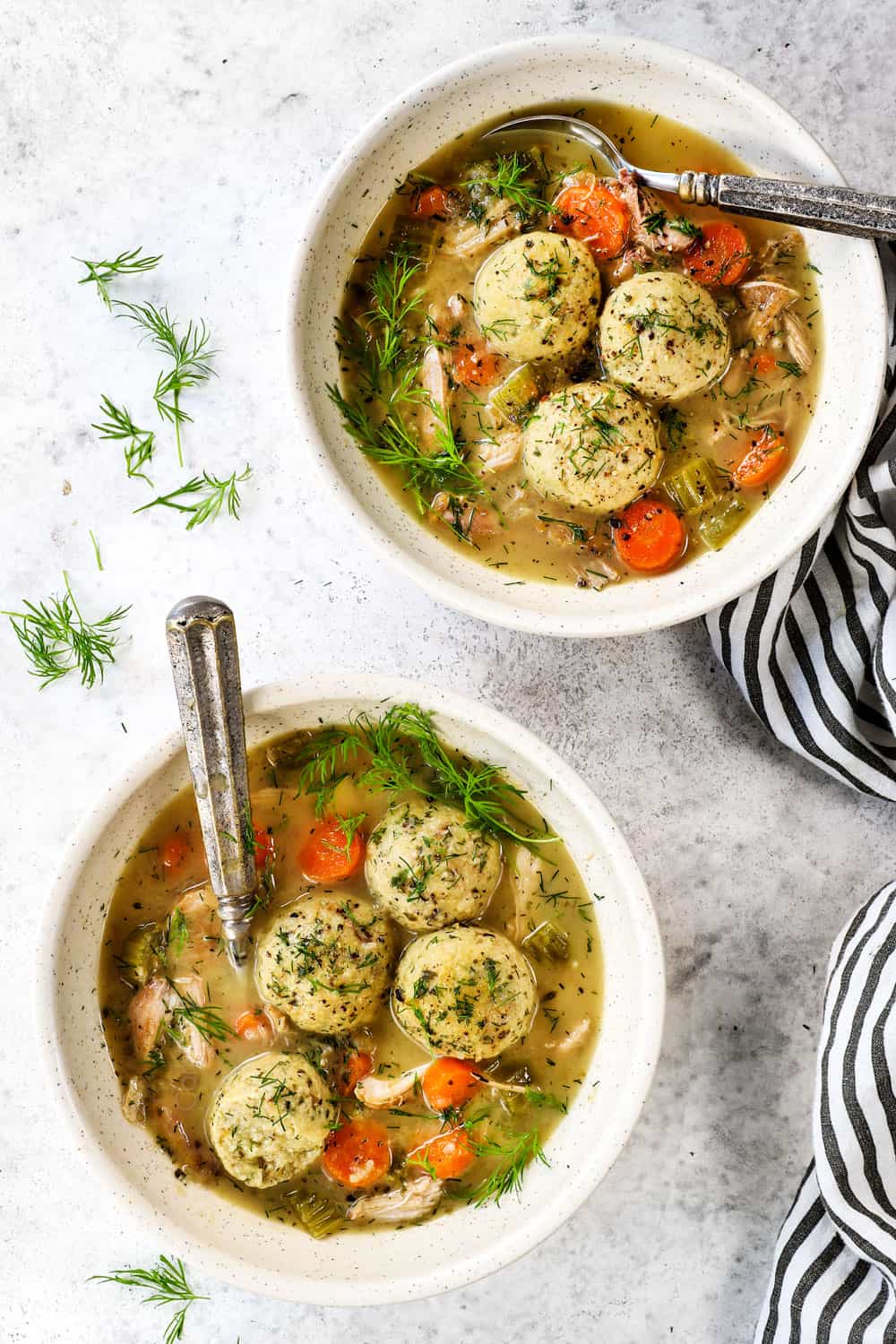
Can You Freeze Matzo Balls?
You can freeze matzo balls either uncooked or cooked and they will retain their flavor and texture very well.
- To freeze cooked matzo balls: Let the cooked dumplings cool completely, then blot them dry. Flash freeze them by lining on a parchment paper lined baking sheet (not touching) and freeze for two hours or until solid. Transfer the dumplings to an airtight freezer safe container or freezer bag and squeeze out excess air to prevent freezer burn. Freeze for up to three months. Reheat matzo balls from frozen by gently simmering in chicken stock or broth until warmed through.
- To freeze uncooked matzo balls: Form the dough into balls then flash freeze them by lining on a parchment paper lined baking sheet (not touching) and freezing for two hours or until solid. Transfer the dumplings to an airtight freezer safe container or freezer bag and squeeze out excess air to prevent freezer burn. Freeze for up to three months. Add the frozen dumplings to simmering chicken stock or broth without thawing and proceed to cook.
HOW TO STORE AND REHEAT
- Storage: Let the soup cool to room temperature, then cover and store in your Dutch oven or transfer to an airtight container. Refrigerate for up to 5 days. There is no need to refrigerate the matzo balls separately.
- To freeze: It is best to freeze the matzo balls separately from the soup so they don’t become mushy. Follow the above freezing instructions for the balls. To freeze the soup, let it cool completely, transfer a freezer-safe container and freeze for up to 3 months. Thaw in the refrigerator overnight. Bring the soup to a simmer before adding the frozen matzah balls.
- To reheat on the stove: Reheat large batches on the stove over medium low heat, stirring occasionally until warmed through, adding additional broth as needed.
- Microwave: Transfer soup to a microwave-safe dish, cover with a microwave-safe lid or paper towel. Microwave for 90 seconds, stir, then continue to microwave for 30-second intervals, if needed.
WHAT TO SERVE WITH EASY MATZO BALL SOUP?
This Matzo Ball Soup is hearty and comforting full of protein, carbs and veggies, so it doesn’t need much as far as sides go. We love this cozy soup with fresh sides such as salad and fruit. Here are some of our favorites (note that some of these are not kosher for Passover, so you’ll need to skip the dairy/cheeses):
- Salad: Caesar Salad, Wedge Salad with Blue Cheese Ranch, Cucumber Tomato Salad, Strawberry Salad, Apple Salad, Pear Salad, or Green Bean Salad.
- Fruit: Bright, fresh fruit is always a welcome side to any cozy soup. Go as simple as grapes, melon, etc. or you’ll love Fruit Salad with Honey Lime Vinaigrette, Winter Fruit Salad with Honey Lime Poppy Seed Vinaigrette or Pina Colada Fruit Salad.
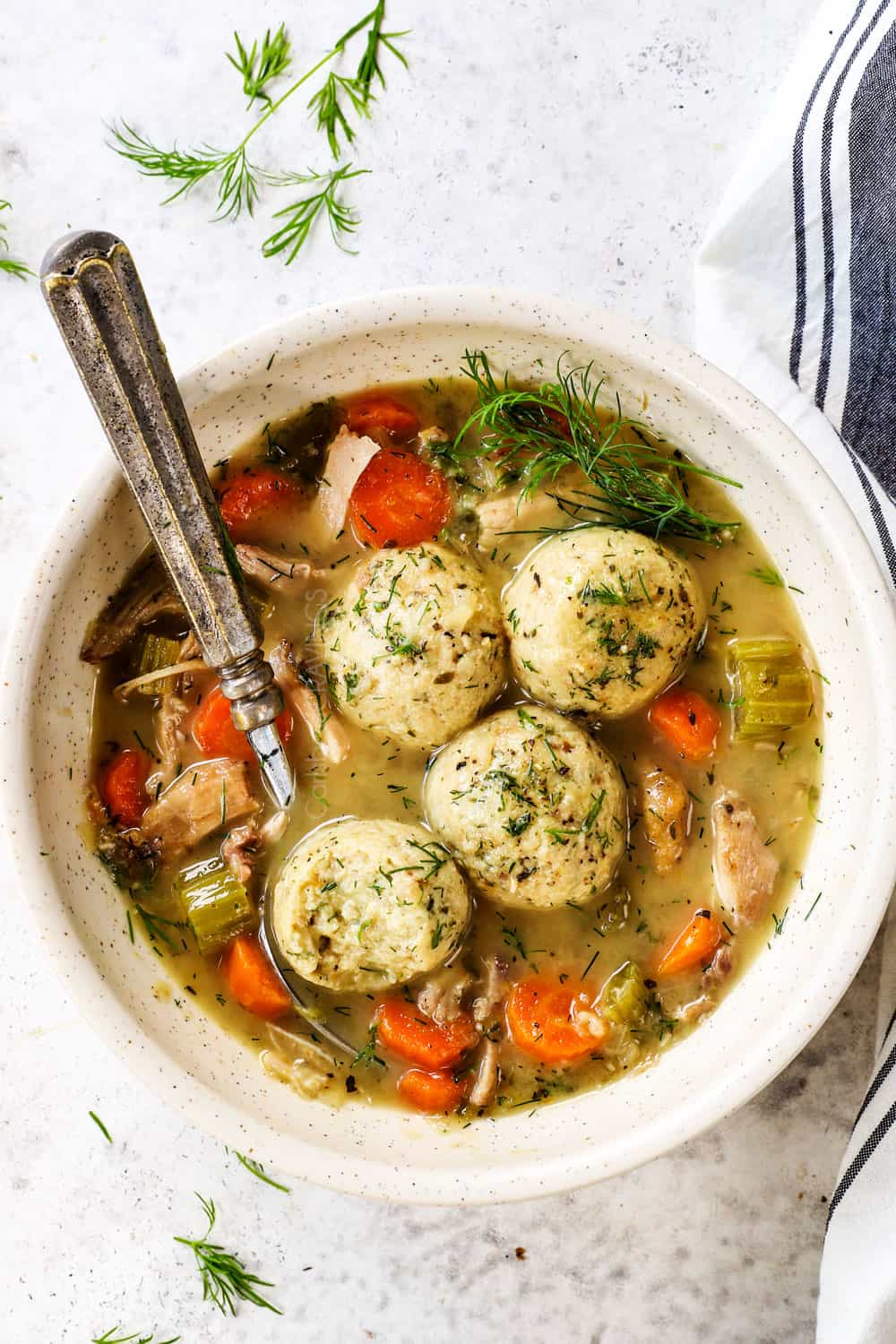
Matzo Ball Soup FAQS
The exact origin of Matzo Ball Soup is unknown; however, an early recipe for the soup is found in The Jewish manual, or, Practical information in Jewish and modern cookery from 1846. It is believed that matzo balls were adapted from the German knödel, a bready dumpling, in the Middle Ages, in answer to dietary restrictions. Jewish cooks started using broken matzo with some kind of fat like chicken or beef marrow and combining it with eggs, onion, ginger, and nutmeg in order to make dumplings to add to their soups.
Matzo Ball Soup is a classic recipe from Eastern Europe that is served on the Jewish holiday of Passover. My mother-in-law, who is of Jewish ancestry, introduced me to this soup which can be enjoyed year-round by anyone!
Matzo Ball Soup is traditionally served on the Jewish holiday of Passover, although much like chicken noodle soup, it is popular year-round. It is also commonly enjoyed at Rosh Hashanah, Hanukkah and Yom Kippur.
Matzo Ball Soup is satisfying comfort food that’s a cross somewhere between chicken noodle soup and chicken dumpling soup. It is distinguished by the soothing, rich, aromatic broth and either soft and fluffy or dense matzo meal dumplings.
Matzo meal is made of matzah, a crisp, flat, unleavened bread, made of flour and water, which must be baked before the dough has had time to rise. The bread is ground into fine crumbs to make matzo meal.
Yes, matzo balls are made of unleavened ground matzah combined with eggs, schmaltz and herbs. When the Israelites fled slavery in Egypt they didn’t have any time to wait for their bread to rise. Matzah balls eaten during Passover serve as a reminder of their exodus.
Matzah, sometimes spelled matzoh, is from the Hebrew matztzah, meaning “unleavened bread,” or literally, “juiceless.” It is also called the Bread of Affliction, (Lechem Oni in Hebrew), eaten by Jews during the holiday of Passover (Pesaḥ) in commemoration of their exodus from Egypt, from slavery to freedom.
Matzo balls are type of kosher dumpling added to soups or stews. They are different than traditional dumplings in that they are made with schmaltz instead of butter and matzo meal, ground matzo crackers made of wheat flour and water, instead of flour. Traditional dumplings are made with butter cut into all-purpose flour in order to bind the ingredients together.
Matzo Ball Soup contains lean protein chicken and vegetables in a dairy free broth. The matzo balls, however, are made with schmaltz which is rendered chicken fat which is high in calories. You can reduce the schmaltz by 1 tablespoon if you’re looking to save on some calories or swap some of it with a neutral healthier fat such as olive oil or avocado oil but this will compromise the flavor.
Matzo is Pasha keto-friendly because it is high in carbs. It may kick you out of ketosis even with a small serving size.
You can store Matzo Ball Soup in an airtight container in the refrigerator for up to 5 days; there is no need to separate the matzo balls. For longer storage, separate the matzo balls from the soup and freeze separately.
No, it is actually the opposite. Cooking the matzo balls for less time will yield firmer dumplings because there is less time for the broth to penetrate the dumplings. Cooking the matzo balls for longer will yield softer dumplings because they will soak up more of the liquid.
Yes, if you cook matzah balls too long, they can become water logged and mushy. Check them at 25 to 30 minutes.
Adding too much liquid in ratio to matzo meal can make for mushy dumplings. Stick with 1 tablespoon broth for every ¼ cup matzo meal. Also, if the balls are cooked for too long, they will lose their toothsome quality and can become waterlogged and mushy.
It is crucial to let the matzo meal rest for at least 30 minutes to absorb the liquid to form a cohesive dough. If you form the balls while its still fresh, they won’t hold together while simmering and will fall apart.
To keep the meal kosher, Matzo Ball Soup can be served with beef brisket, grilled or baked fish, roasted vegetables or salad with vinaigrette.
Matzah balls are traditionally eaten in a chicken stock-based soup, however, that doesn’t mean you can’t eat them alone! Serve them as a side to your favorite beef brisket, chopped liver, chicken or roasted fish.
There are two camps of people, those who like their matzo balls to float “floater” and those who prefer them to sink, “sinkers.” If you prefer dense matzo balls, they will sink in the soup and have a rich, toothsome quality, whereas floater will be airy, soft and fluffy.
To make dense matzo balls, you want to incorporate as little air into the dough as possible so avoid carbonated water and baking powder.
The addition of anywhere from ¼ teaspoon to ¾ teaspoon of baking powder will promote lighter matzo balls. Carbonated water can also be used in place of broth along with 1/8-½ teaspoon baking powder. Lastly, the dough needs at least 30 minutes to rest, and for lighter dumplings, upwards of two hours so there is adequate time for the dough to hydrate which will lead to greater expansion and lightness.
LOOKING FOR MORE CHICKEN SOUP RECIPES?
- Chicken Enchilada Soup
- Crockpot Creamy White Chicken Chili
- Chicken Pot Pie Soup
- Chicken and Wild Rice Soup
- Crockpot Chicken Tortilla Soup
- Chicken Fajita Soup
- Copycat Olive Garden Chicken and Gnocchi Soup
- White Chicken Lasagna Soup
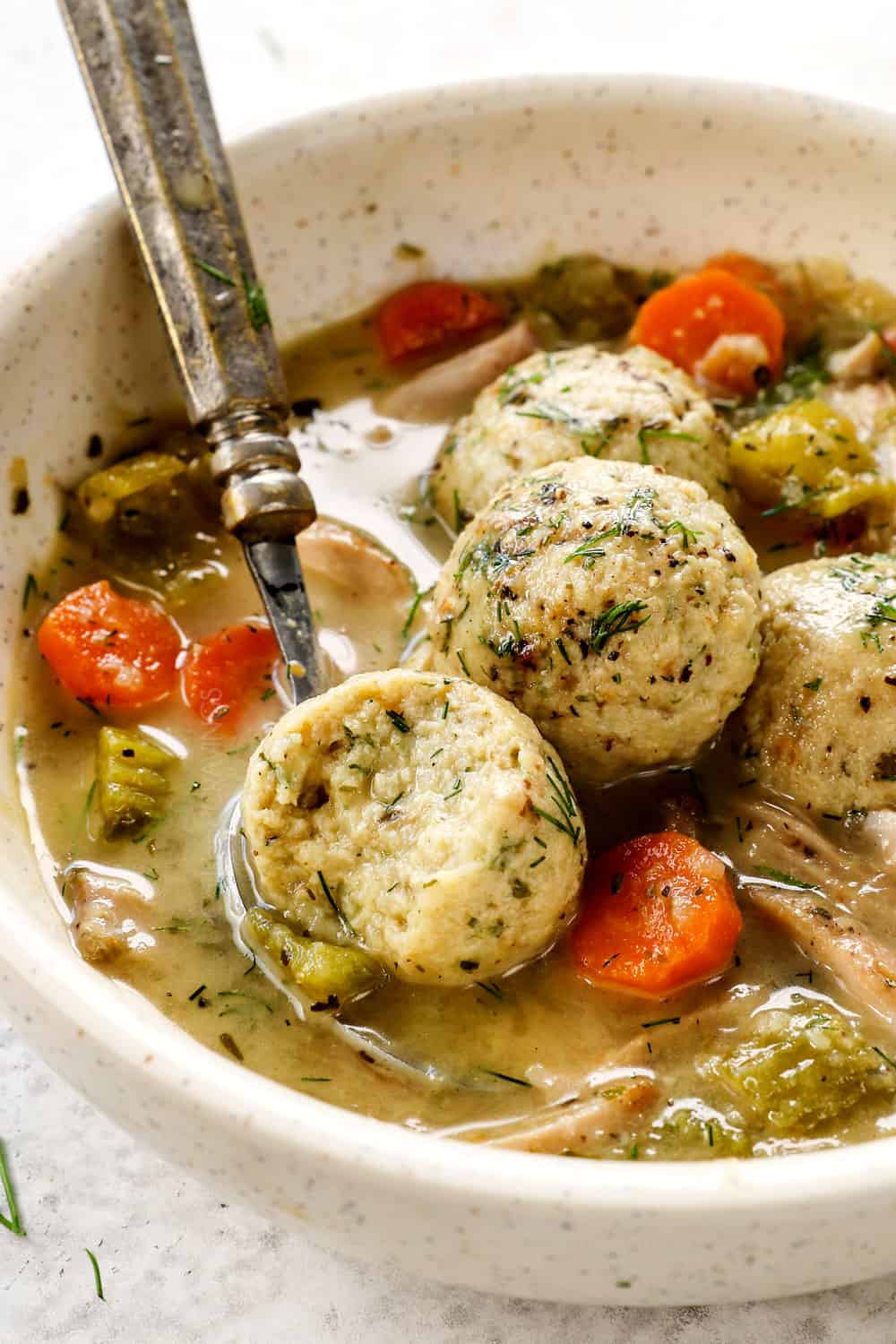
WANT TO TRY THIS MATZO BALL SOUP RECIPE?
PIN IT TO YOUR Holiday, SOUP OR CHICKEN BOARD TO SAVE FOR LATER!
FIND ME ON PINTEREST FOR MORE GREAT RECIPES! I AM ALWAYS PINNING :)!
©Carlsbad Cravings by CarlsbadCravings.com

Matzo Ball Soup
Save This Recipe To Your Recipe Box
You can now create an account on our site and save your favorite recipes all in one place!
Ingredients
THE MATZO BALLS
- 3/4 cup matzo meal
- 1 TBS EACH minced fresh dill, fresh parsley (or 1 tsp EACH dried)
- 1 tsp salt
- 3/4 tsp baking powder (see notes for Passover options)
- 1/4 tsp EACH onion powder, garlic powder
- 1/8 teaspoon pepper
- 3 large eggs
- 3 tablespoons schmaltz (see notes)
- 3 tablespoons chicken broth
THE SOUP
- 1 pound bone-in-chicken thighs or breasts, skin removed (see options in notes)
- 2 tablespoons olive oil
- 1/2 tsp EACH salt, pepper
- 1 tablespoon chicken schmaltz (may sub olive oil)
- 1 cup carrots, sliced ¼-inch thick
- 1 cup celery, sliced ½-inch thick
- 1 onion, diced
- 4-6 garlic cloves, minced
- 10 cups low sodium chicken broth (or homemade stock)
- 1 teaspoon chicken bouillon or better than bouillon
- 1 tsp EACH dried parsley, dried oregano, dried basil
- 1/2 teaspoon dried thyme
- 2 bay leaves
ADD LATER
- 1 tablespoon fresh chopped dill, more or less to taste
Instructions
Mix the matzo ball dough:
- In a medium bowl, whisk together the matzo meal, dill, parsley, baking powder, salt, garlic powder, onion powder, and pepper. In another small mixing bowl, whisk together the eggs, schmaltz (or oil) and chicken broth. Pour the egg mixture into the dry ingredients and fold together just until combined; do not over-mix.
- Cover and refrigerate the dough for at least 30 minutes or until ready to use, up to 2 days ahead of time.
Start the Soup:
- While the matzo ball dough is resting, make the soup. Pat chicken dry with paper towels; sprinkle with salt and pepper. Let stand while you prep the vegetables.
- Heat two tablespoons olive oil over medium-high heat in a large Dutch oven or soup pot. Sear chicken until golden, about 3 minutes per side. Remove to a plate but leave the drippings.
- Heat one tablespoon schmaltz or oil over medium-high heat with the drippings. Add onions, carrots and celery and sauté until the onions are tender, scaping up the golden bits on the bottom of the pan; add garlic and sauté one minute.
- Add chicken back to the pot. Add chicken broth, bouillon and all dried seasonings up to dill (don't add dill). Cover the soup and bring to a boil over high heat then reduce heat to low and continue to simmer for approximately 20 minutes, stirring occasionally, or until chicken is tender enough to shred. Meanwhile:
Make the Matzo Balls:
- While the chicken is simmering, line a 9×13 baking dish or large plate with parchment paper to receive matzo balls. Wet your hands with cold water, then roll scoops of batter into balls (about 1 tablespoon each, I use a cookie scoop), handling them as gently as possible.
- Place the balls on the parchment, cover, and refrigerate until ready to use. You can also make the balls any time after the dough as rested 30 minutes and refrigerate covered for up to 2 days
Cook the Matzo Balls:
- Once the chicken is tender, transfer chicken to a cutting board and shred into bite-size pieces then return to the soup.
- Return the soup to a simmer. Drop the balls into the simmering soup, cover and simmer for 25-30 minutes, until they are plump and cooked through. Stir the dill into the soup. Add additional broth/stock if desired for a less chunky soup. Ladle soup into bowls and serve immediately.
Video
Notes
Ingredient Notes
- Matzo meal: You can find matzo meal in the same aisle as the breadcrumbs. I use commonly found Manischewitz Matzo Meal. Do NOT confuse matzo meal with matzo ball mix!
- Is baking powder kosher? Baking powder is an artificial, mineral based, non-grain-based form of leavening, and therefore it does not fall under the group of foods that are banned for Passover according to many rabis. See this New York Times article for more info. Still, some choose not to use baking powder to keep with the spirit of the Passover, in which case there are several baking powder brands stated “certified for Passover” or they may say Parve or Pesadich. This one by Gefen sold on Amazon is a popular choice.
- Schmaltz: Also known as liquid gold, schmaltz is fantastically rich rendered poultry fat (usually chicken) and HIGHLY recommend if you’re serious about making the most tantalizing dumplings with concentrated flavor. It also promotes more tender dumplings. Look for schmaltz in the kosher section of your grocery store, stocked near the oils, in the freezer section, or ask the butcher, they often sell it directly. You can also purchase it on Amazon here or you can make your own schmaltz.
- What if I don’t have schmaltz? If you can’t get your hands on schmaltz, you can swap it for a neutral oil such as vegetable oil or canola oil, but as the descriptor implies, these are lacking in flavor and won’t make the tastiest dumplings. You can also use unsalted melted butter but this is not kosher during Passover.
- Chicken: I highly recommend bone-in chicken thighs with the skin removed. The succulent, rich dark meat and bone makes for extra rich broth and tender chicken. You can absolutely still use chicken breasts for this recipe if that is what you prefer but I don’t find breasts as juicy or flavorful. I recommend using chicken stock if using chicken breasts. You will want to slice your breasts in half through the equator if they are extra-large, otherwise, the simmer time will be much longer and the veggies can break down too much.
- Chicken bouillon: You can use granulated bouillon (powder), bouillon cubes or better than bouillon in equal amounts. Add the bouillon to the soup without dissolving in liquid first.
- Should I cook the matzo balls in water or the chicken stock? Matzo balls are little sponges and will soak up anything they are cooked in. If cooked in water, they will be bland, if cooked in broth, they will be full of flavor. For ease, I cook the dumplings directly in the soup; it saves you from dirtying another pot and makes for the most flavorful matzah balls. Cooking the dumplings directly in the soup will make it a little cloudy due to the starch (I don’t mind a bit), so if this bothers you, then cook the balls in a separate pot of 2 quarts of simmering broth and reduce the broth in the soup.
How to make floaters or sinkers:
My personal preference, used in the recipe card, is to use baking powder and chicken broth. These middle ground dumplings are light, soft and tender, able to absorb broth but still hearty enough to not border on mushiness. For more options:- For the lightest matzo balls: use seltzer water in place of the broth and add anywhere from ¼ teaspoon to ¾ teaspoon baking powder (more baking powder will yield increasingly light matzo balls; ¾ teaspoon with be insanely light)
- For matzo balls slightly lighter on the outside but still a bit dense in the middle: use seltzer in place of the broth and skip the baking powder OR skip the seltzer and use only 1/4-½ teaspoon baking powder
- For dense matzo balls: skip the baking powder and stick with broth instead of seltzer water.
Make Ahead
- Matzo balls: You can mix the matzo dough up to two days ahead of time and store it covered in the refrigerator. You can also roll the matzo balls up to two days ahead of time. Line the uncooked balls on a parchment paper lined tray (a 9×13 works well), tightly cover and refrigerate until ready to add to the simmering soup.
- Trim chicken: Remove the skin, then store chicken in an airtight container or freezer bag in the refrigerator for up to 24 hours.
- Chop vegetables: Chop the vegetables and aromatics a couple days ahead of time, the night before dinner or just a few hours before cooking, then store in airtight containers in the refrigerator.
- Measure Spices: It doesn’t take long to measure out the herbs and spices, but you can certainly do it beforehand and store the mix in an airtight bag or container.
How to Freeze Matzo Balls
You can freeze matzo balls either uncooked or cooked and they will retain their flavor and texture very well.- To freeze cooked matzo balls: Let the cooked dumplings cool completely, then blot them dry. Flash freeze them by lining on a parchment paper lined baking sheet (not touching) and freeze for two hours or until solid. Transfer the dumplings to an airtight freezer safe container or freezer bag and squeeze out excess air to prevent freezer burn. Freeze for up to three months. Reheat matzo balls from frozen by gently simmering in chicken stock or broth until warmed through.
- To freeze uncooked matzo balls: Form the dough into balls then flash freeze them by lining on a parchment paper lined baking sheet (not touching) and freezing for two hours or until solid. Transfer the dumplings to an airtight freezer safe container or freezer bag and squeeze out excess air to prevent freezer burn. Freeze for up to three months. Add the frozen dumplings to simmering chicken stock or broth without thawing and proceed to cook.
HOW TO STORE AND REHEAT
- Storage: Let the soup cool to room temperature, then cover and store in your Dutch oven or transfer to an airtight container. Refrigerate for up to 5 days. There is no need to refrigerate the matzo balls separately.
- To freeze: It is best to freeze the matzo balls separately from the soup so they don’t become mushy. Follow the above freezing instructions for the balls. To freeze the soup, let it cool completely, transfer a freezer-safe container and freeze for up to 3 months. Thaw in the refrigerator overnight. Bring the soup to a simmer before adding the frozen matzah balls.
- To reheat on the stove: Reheat large batches on the stove over medium low heat, stirring occasionally until warmed through, adding additional broth as needed.
- Microwave: Transfer soup to a microwave-safe dish, cover with a microwave-safe lid or paper towel. Microwave for 90 seconds, stir, then continue to microwave for 30-second intervals, if needed.

Did You Make This Recipe?
Tag @CarlsbadCravings and Use #CarlsbadCravngs
Leave a Review, I Always Love Hearing From You!
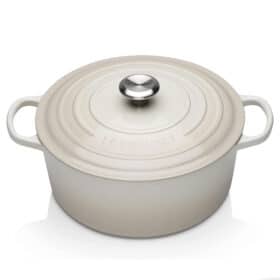
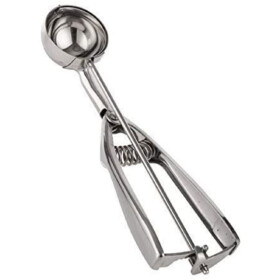
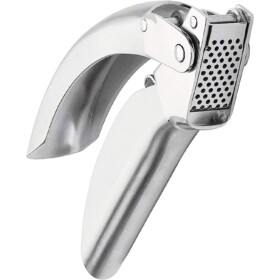
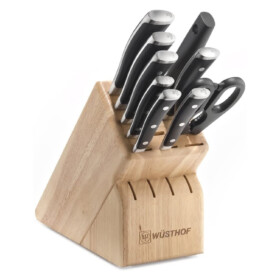
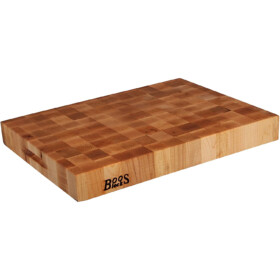
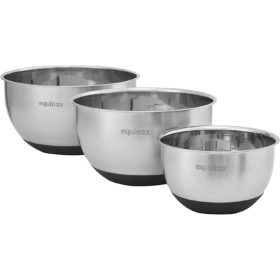
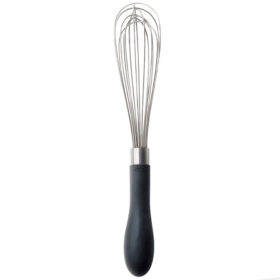
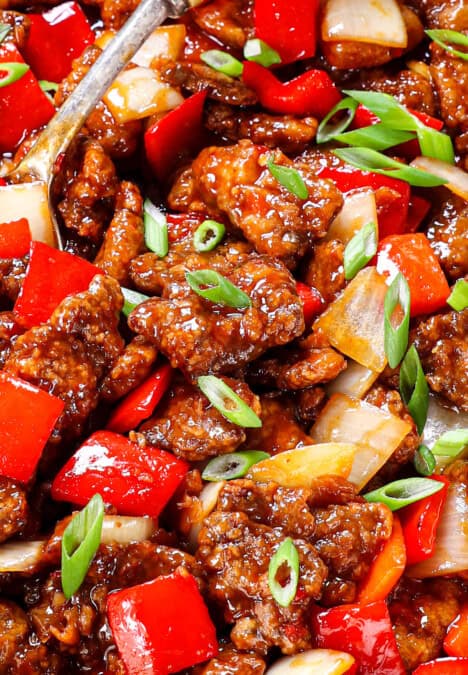
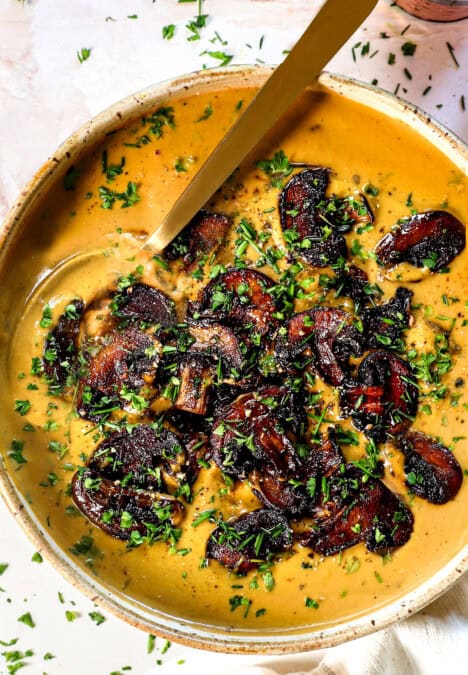
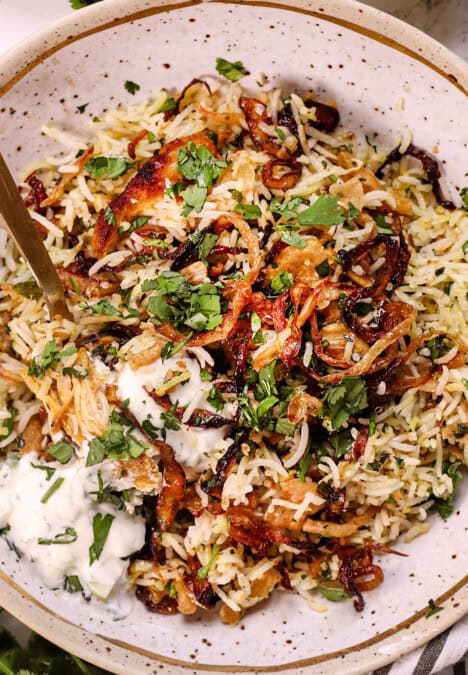
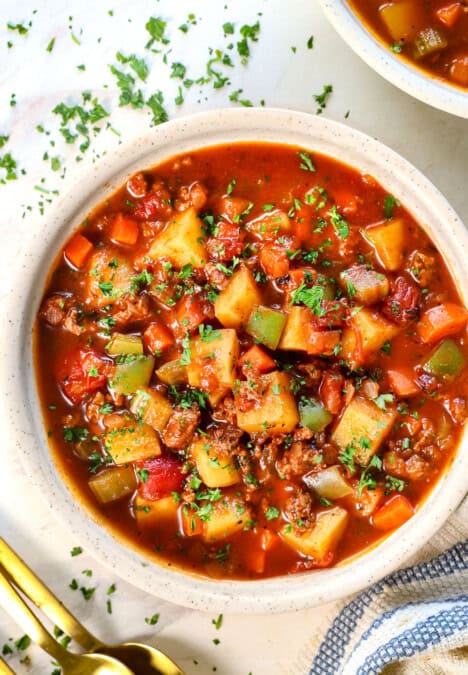
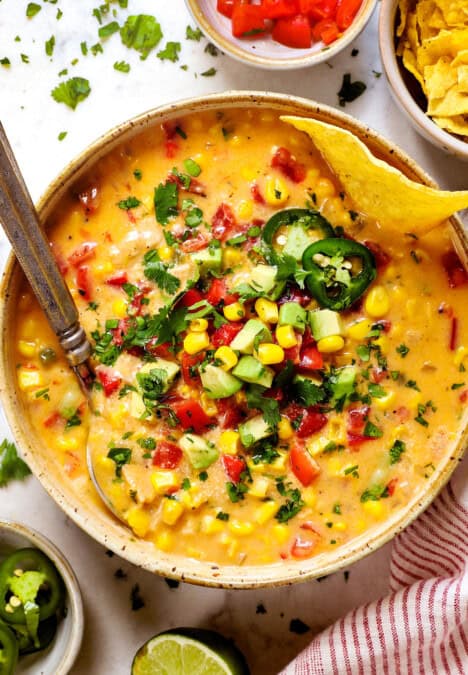
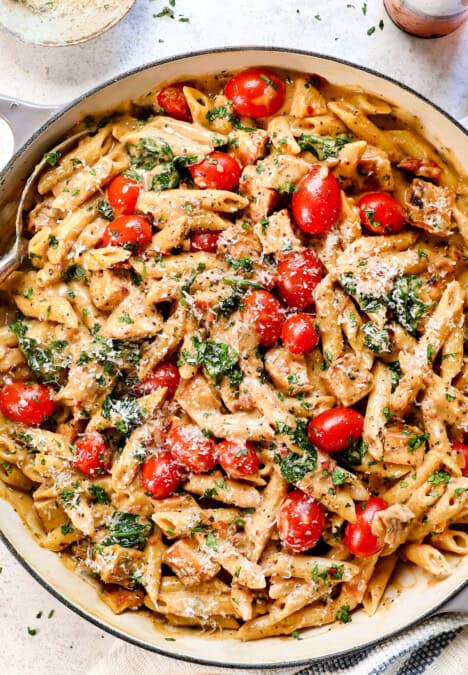


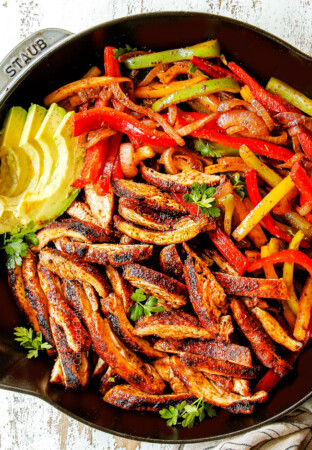
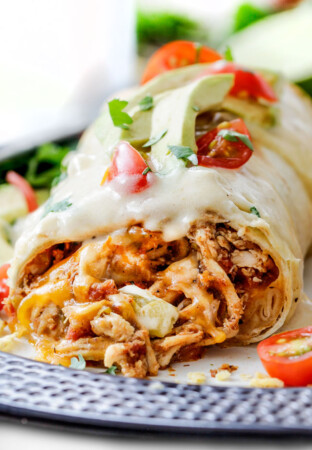
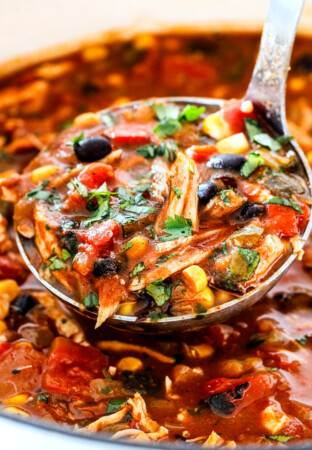
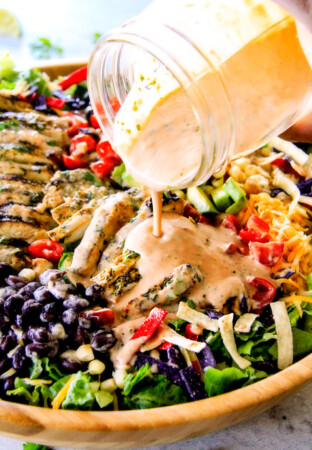
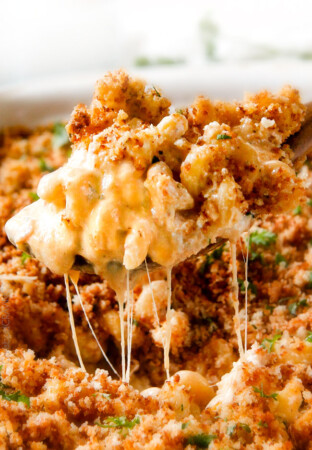
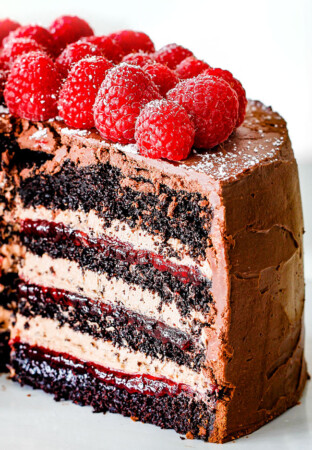
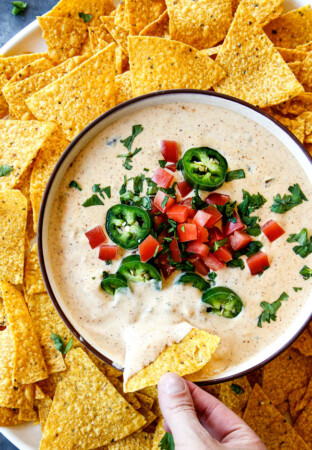
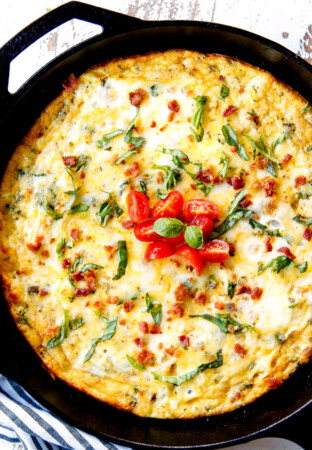
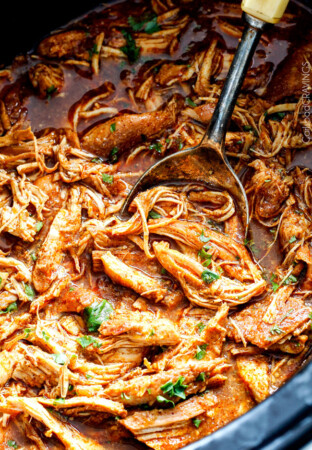
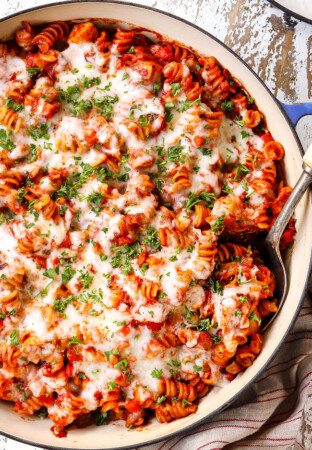

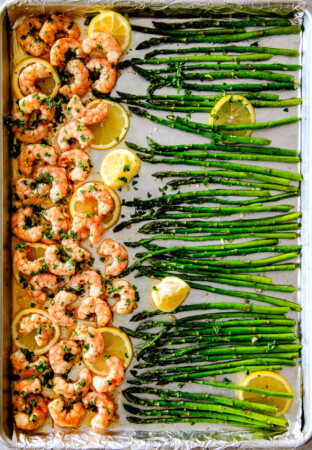
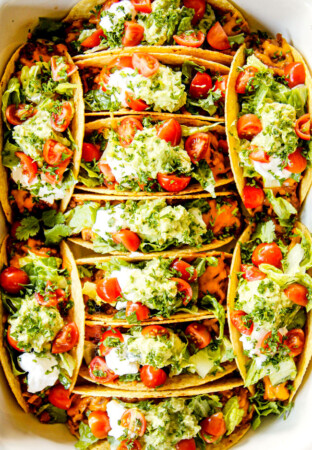
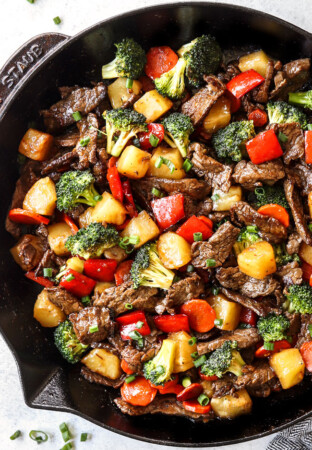
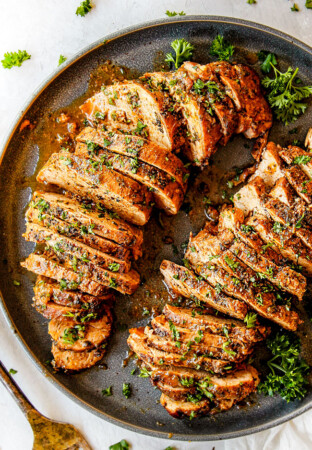
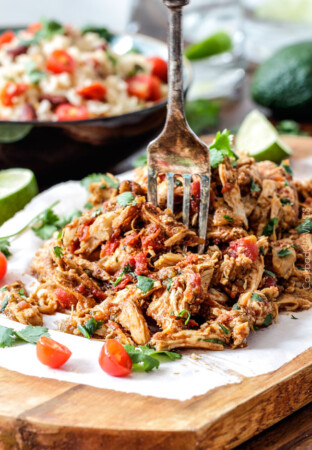
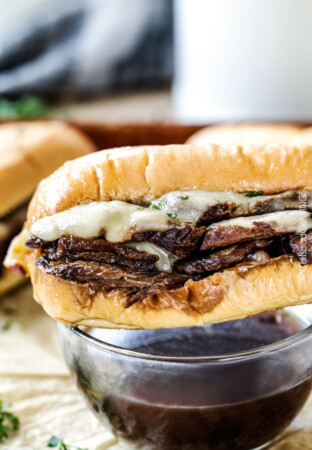
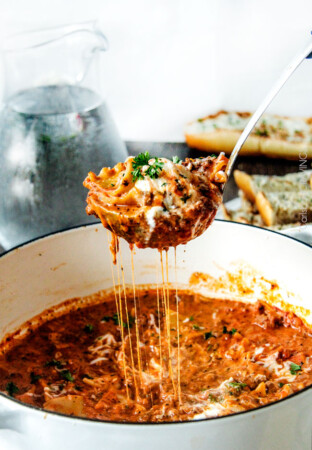
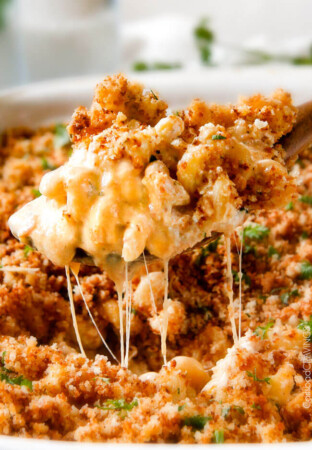
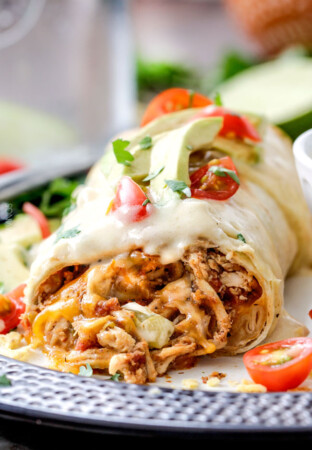
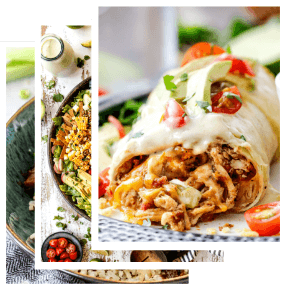
SeafoamJade says
I have a question for you. You say that we can freeze uncooked matzo balls (which is welcome news for me). But I am wondering if freezing them before I cook them will either make them mushy or will somehow ruin the texture. Have you frozen them without cooking them first, yourself? Did it change the texture or the taste, and make them any different from cooking them fresh from after you mixed them? TIA!
Jen says
Hi Tia! They freeze so well, and the texture and flavors are preserved! I hope you will have the same experience!
Josh says
Great looking soup, spot-on recipe I will prepare tonight, and wonderful story. You’re fabulous!
Jen says
Thanks so much for your message Josh! I hope the soup was a hit!